Taipei has always held a special place in our hearts. My partner and I each had separate adventures in this vibrant city long before our paths crossed and we’ve always dreamed about revisiting together. In May 2024, when we got a chance to travel for three months in Asia (will cover that story in another blog post), we immediately chose Taipei as the first stop of our adventure. What made this trip extra special was reuniting with my best friend, who grew up in Taipei. Through her eyes, we experienced Taipei anew, blending familiar comforts with fresh discoveries.
This 4-day Taipei guide combines our carefully curated experiences with local insights. It is perfect for travelers who prefer to savor rather than rush their journeys. Whether you’re planning your first visit or returning to this vibrant metropolis just as we did, join us as we uncover Taipei’s charm through its streets, flavors, and people.
Table of Content
- Getting to Know Taipei: Quick Facts and Must-Know Info
- Our Recommended 4-Day Taipei Itinerary: A Mid-Paced Adventure
- Bonus for Foodies: More Night Markets, Breakfast Spots, and Local Flavors
- Exploring Beyond Taipei: Easy Day Trips Ideas
Getting to Know Taipei: Quick Facts and Must-Know Info
Before diving into our Taipei adventure, here are some essential facts and travel tips to help you navigate the city with ease.
Taipei Quick Facts:
- 📍Location: Taipei is the capital of Taiwan, located in the northern part of the island. It is surrounded by lush mountains, and the Tamsui River flows through the city. Known for its mix of modern skyscrapers, traditional temples, and vibrant street life, Taipei is the political, economic, and cultural heart of Taiwan.
- 👥 Population: Taipei is home to around 2.5 million people, making it Taiwan’s largest city and capital. Despite its size, it’s well-organized, efficient, and incredibly welcoming to visitors.
- 🗣 Language: The official language is Mandarin Chinese, but many locals, especially younger generations and those in the tourism industry, understand basic English. Signs in MRT stations and major attractions are in both Chinese and English, making navigation easier.
- 💰 Currency: Taiwan’s currency is the New Taiwan Dollar (NTD or TWD). Credit cards are widely accepted in shopping malls and restaurants, but smaller vendors, night markets, and some traditional eateries operate on a cash-only basis. ATMs are widely available, and mobile payment options like Line Pay and Apple Pay are becoming more common.
- 🔒 Safety in Taipei: Taipei is consistently ranked as one of the safest cities in the world. Violent crime is rare, and the city is very walkable, even at night. However, as with any major city, stay aware of your belongings in crowded areas like night markets and MRT stations. Respect local customs—when visiting temples, dress modestly and avoid loud conversations.
Best Time to Visit Taipei:
☀️Taipei is a year-round destination, but the best time to visit depends on what you’re looking for:
- Spring (March–May): Mild weather, cherry blossoms, and fewer crowds.
- Summer (June–August): Hot and humid, but lively night markets and summer festivals make up for it. Be mindful of occasional typhoons.
- Autumn (September–November): Pleasant temperatures, clear skies, and the best time for outdoor activities.
- Winter (December–February): Cooler and damp but still comfortable. A great time for hot springs and festive lights during Lunar New Year.
Getting to Taipei & Getting Around:
✈️ Taipei is served by two main airports:
- Taoyuan International Airport (TPE) – The main gateway for international flights, located about 40 km (25 miles) from the city center.
- Songshan Airport (TSA) – A smaller airport within Taipei that mainly handles domestic and regional flights to nearby countries like Japan and China.
🚇 Taipei has one of the best public transportation systems in the world—efficient, affordable, and easy to navigate.
- MRT (Mass Rapid Transit 捷運): The fastest and easiest way to explore Taipei. It’s clean, reliable, and tourist-friendly. Purchase an EasyCard (悠遊卡) or iPASS (一卡通) for cashless travel on MRT, buses, and YouBike rentals.
- Buses: Great for reaching places not covered by the MRT.
- Taxis & Uber: Taxis are affordable but may require basic Chinese skills to communicate with drivers. Uber is available and often more convenient for travelers.
- YouBike (Public Bike Rental): A fun and eco-friendly way to explore the city, especially along riverside parks and scenic areas.
With these basics in mind, you’re all set to explore Taipei like a pro! 🚀
A Mid-paced 4-Day Taipei Itinerary
- Day 1: Local Life in Ximending & Dadaocheng
- Day 2: Mountain Views and Cultural Treasures
- Day 3: Tea and Tranquility in Maokong and Taipei Grand Hike
- Day 4: Culture, Creativity and Culinary Delights
To enhance your journey, we’ve included a custom map featuring all the key stops outlined in this itinerary. Just click, navigate, and let the vibrant city of Taipei take care of the rest. Ready to go? Let’s hit the road and explore Taipei’s charming streets, rich culture, and delicious flavors now!
Day 1: Local Life in Ximending & Dadaocheng
A Traditional Taiwanese Breakfast Start
⏰ 9:00 AM – 10:00 AM (Day 1)
Following the simple rule of food-hunting—“follow the lines”—we found a bustling breakfast spot near📍Ximending Station (西门町站). The crowd, made up of locals and visitors like us, was a good sign. The smell of freshly fried dough and warm soy milk filled the air, making it the perfect start to our day.

Our breakfast spread contained everything I love about Taiwanese morning ritual: crispy fried dough sticks (油條) paired with warm, sweet soy milk (豆漿), Taiwanese turnip cake (台式蘿蔔糕) with its perfectly crispy exterior giving way to a tender center, and freshly made egg pancakes (台式蛋餅) with that distinctive chewy texture that’s hard to find outside Taiwan.

Local Tip: Although a lot of the breakfast spots open till early afternoon, you typically get the most vibrant atmosphere by 10:30am, so set that alarm early – trust me, it’s worth it.
The Red House & Ximending District
⏰ 10:00 AM – 11:30 AM (Day 1)
Our next stop was the iconic📍Red House (西門紅樓), an octagonal brick building that has witnessed over a century of Taipei’s evolution. Built as Taiwan’s first public market in 1908, it’s fascinating how this space has transformed while preserving its historic charm. Today, it hosts art exhibitions, indie designer boutiques, and weekend craft markets that fill the courtyard with creative energy. The photo displays chronicling the building’s history particularly caught our attention, showing its journey from market to bookstore to theater, and finally to its current role as a cultural hub.

Gateway to Old Taipei
⏰ 11:30 AM – 12:00 PM (Day 1)
A short walk brought us to📍Taipei North Gate (臺北府城北門), the only fully preserved gatehouse from Taipei’s historic city walls. Standing before this Qing Dynasty structure, we imagined how bustling trade and activity once flowed through its arches. The second floor was closed for preservation during our visit. So we strolled around the ground level and appreciated its commanding presence and architectural details.

Discovering Dadaocheng’s Charm
⏰ 12:00 PM – 1:30 PM (Day 1)
📍Dadaocheng (大稻埕) used to be the commercial and trading center of Taipei and one of Taipei’s most prosperous districts during the late Qing Dynasty. Nowadays, it is a place where historic charm and colonial architecture meets modern-day tea shops and quirky boutiques. Stepping into Dadaocheng feels like walking through different epochs of Taipei’s history. Along📍Dihua Street (迪化街)- the oldest street in Taipei, traditional Chinese medicine shops fill the air with distinctive aromas, while vintage household tools shops offer traditional bamboo baskets that are now considered by many, trendy interior decors. My friend challenged us to try mullet roe (乌鱼子), a local delicacy that’s definitely an acquired taste but offers a genuine glimpse into Taiwan’s culinary heritage.
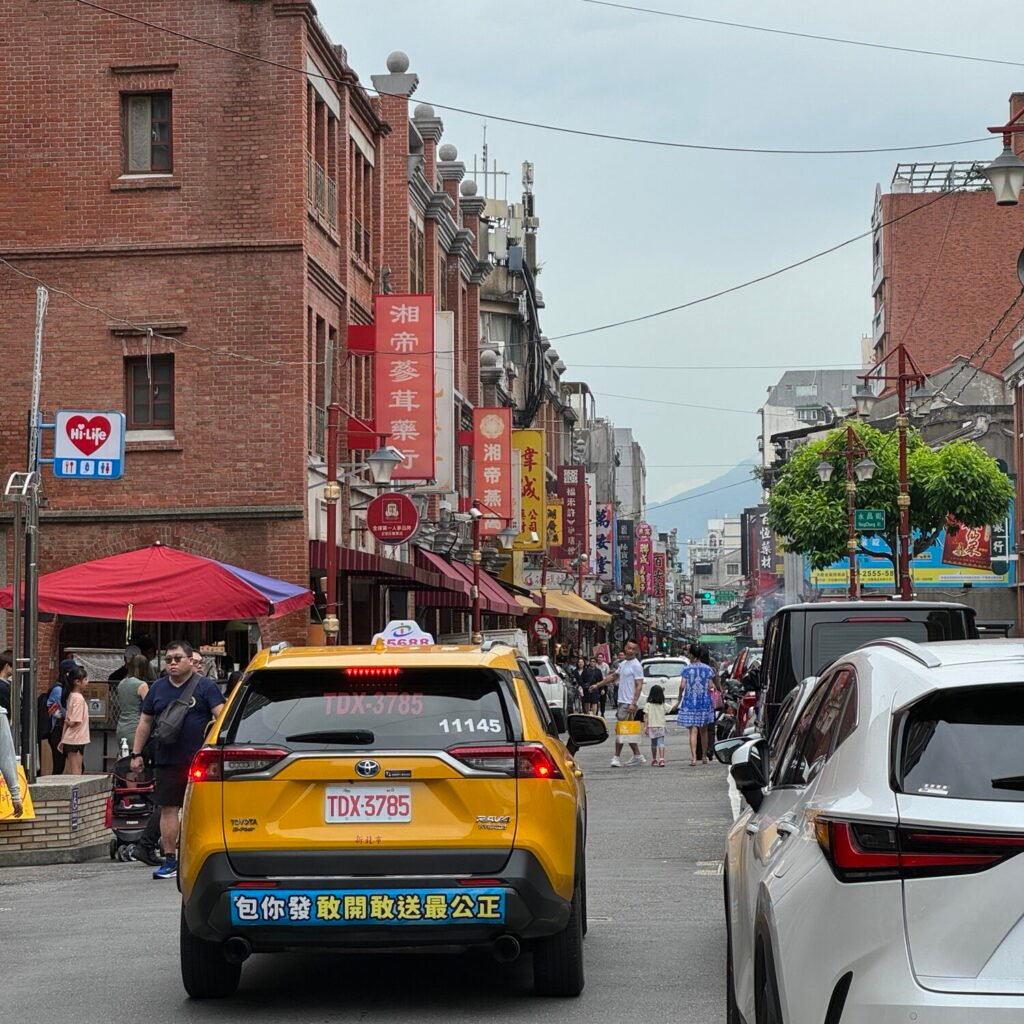
The📍Taipei Xia Hai City God Temple (台北霞海城隍廟) provided a peaceful respite from the street’s bustle. Known for its matchmaking powers, we couldn’t resist offering a prayer for continued happiness, even though we’re already partnered – who would refuse extra blessings?
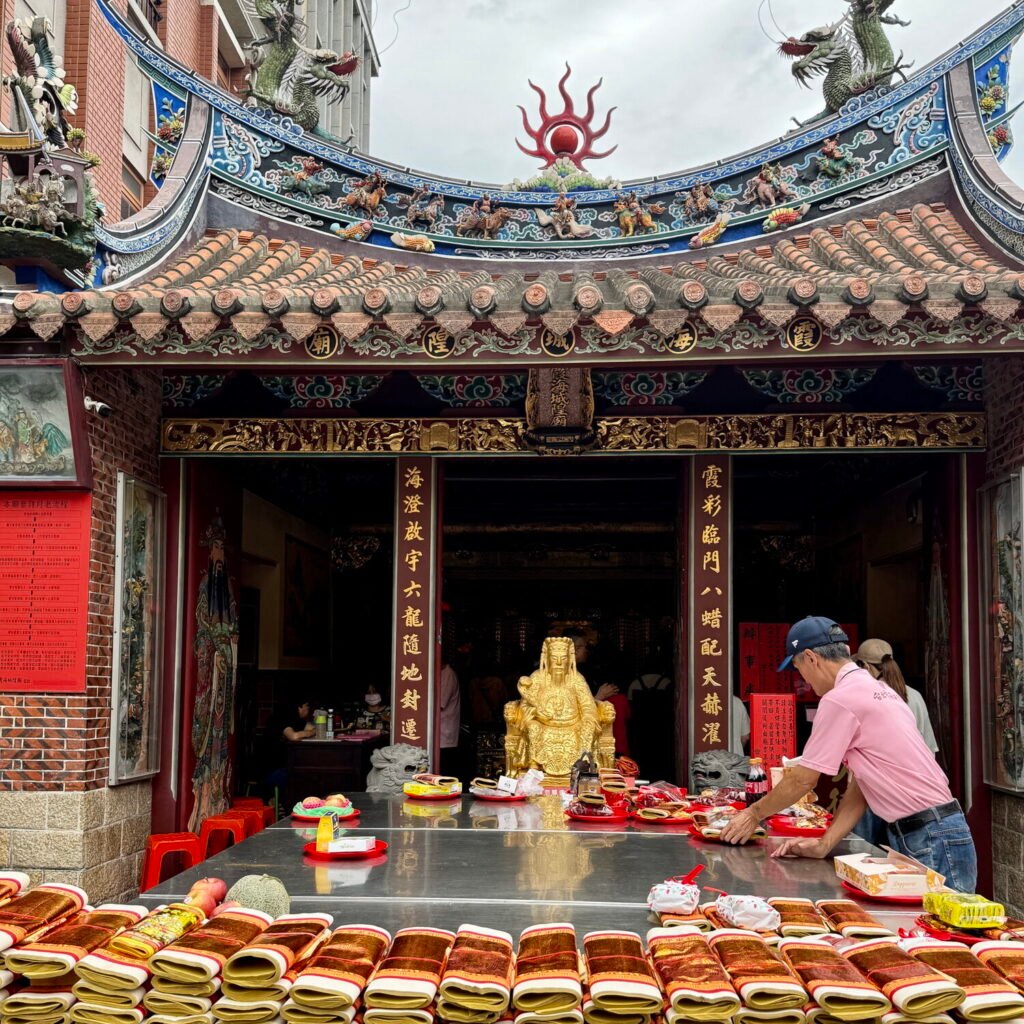
📍Yong Le Market (永樂市場) was the next highlight, in particular its fabric section, which transported me back to childhood memories of shopping with my mother and aunts. When we visited, an exhibition about school life in Taiwan in the 1950s was on display, adding an unexpected layer of nostalgia to our visit.
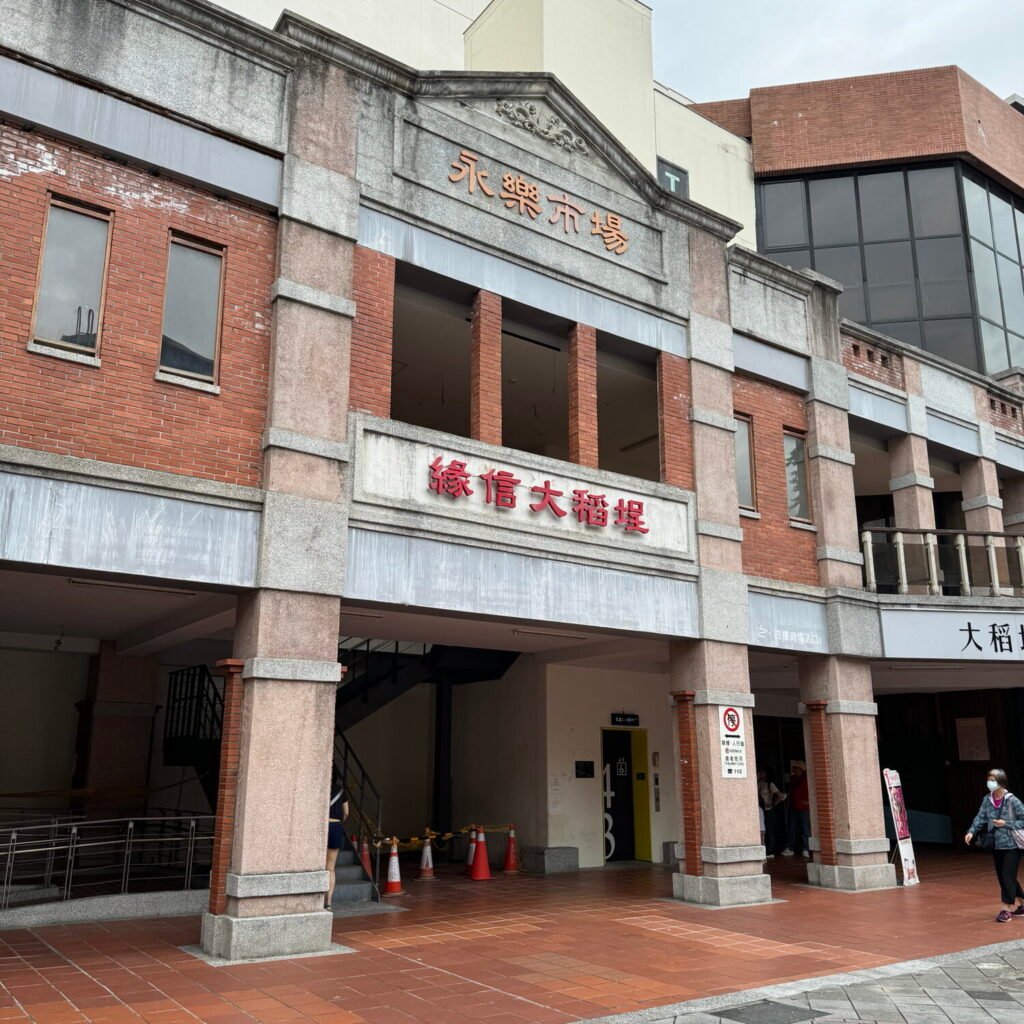
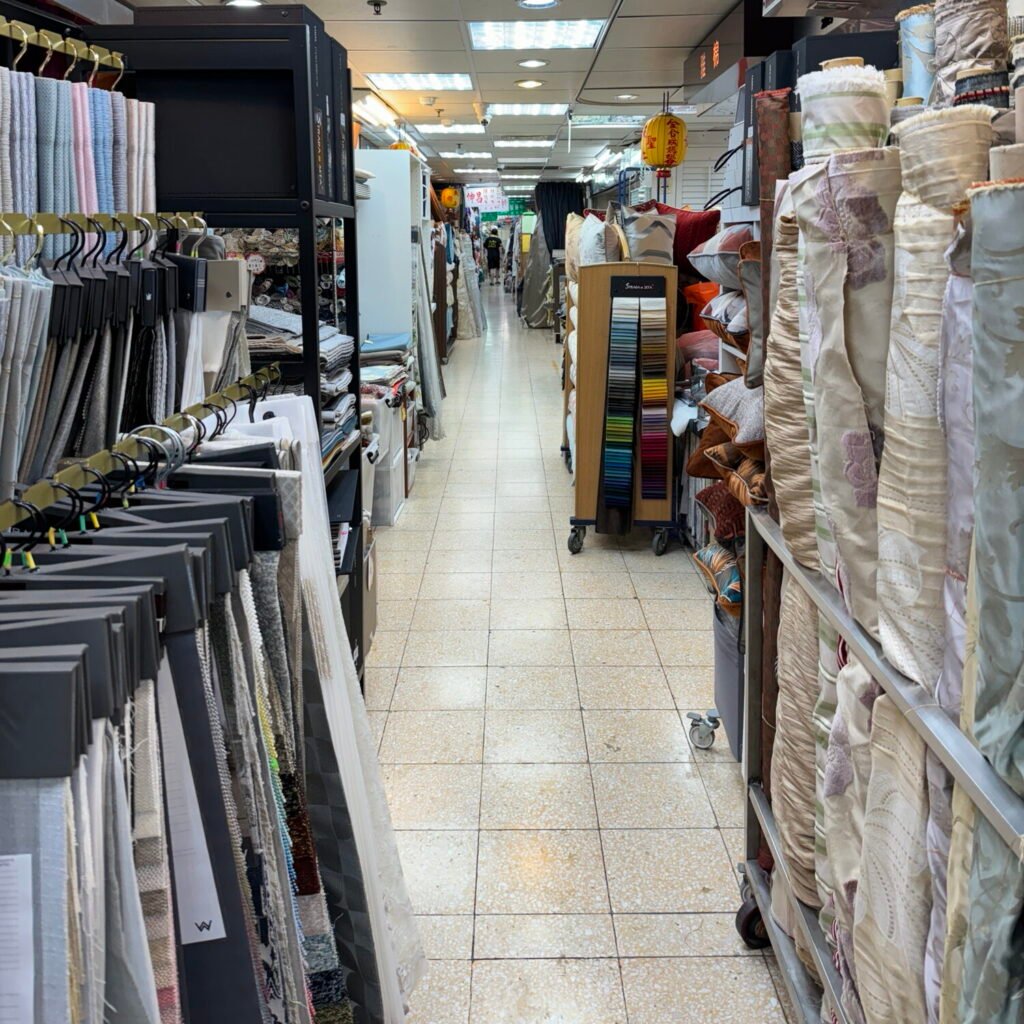
Riverside Reflections
⏰ 1:30 PM – 2:30 PM (Day 1)
Our afternoon led us to📍Yanping Riverside Park (延平河濱公園), where locals jogged and cycled along the waterfront paths. The adjacent📍Dadaocheng Wharf (大稻埕碼頭) area has been cleverly reimagined with creative container shops and a spacious plaza. My friend shared that this spot transforms as day turns to night, with food stalls and live music creating an entirely different atmosphere.
Mental note: come back for sunset next time.


A Modern Break in Historic Surroundings
⏰ 2:30 PM – 4:30 PM (Day 1)
Tired from all the walking, we headed to📍COFE 喫茶 · 咖啡 for an afternoon break. This cafe is tucked away on the second floor of a historic building. It perfectly represents modern Taipei’s talent for blending old and new – traditional tea service alongside award-winning tea-infused chocolates. Time seemed to slow down as we caught up over perfectly brewed tea and artisanal sweets, the afternoon light filtering through historic windows.
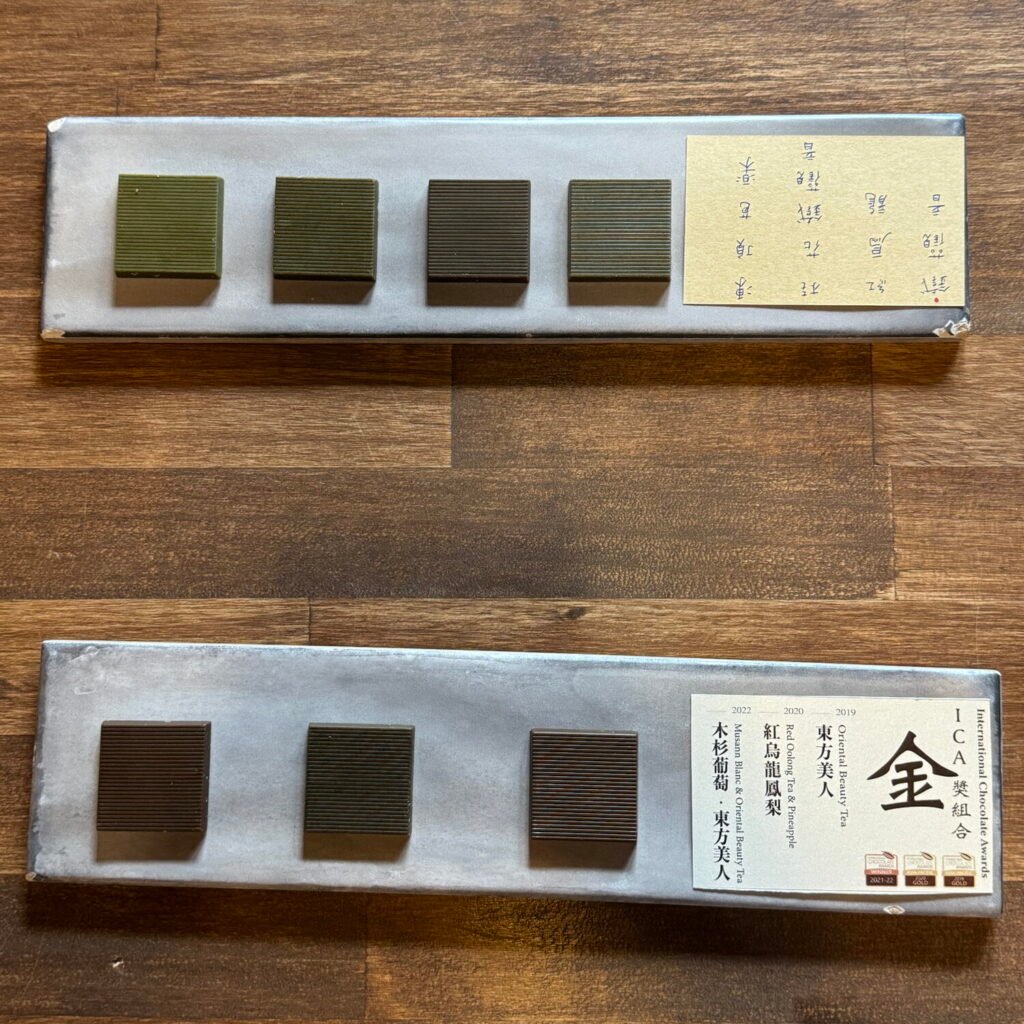
Pre-Dinner Heritage Walk
⏰ 4:30 PM – 5:30 PM (Day 1)
With dinner plans ahead, we decided to walk off our cafe indulgences by exploring more of Dadaocheng’s historic landmarks. The📍Ten Consecutive Buildings (迪化街十連棟) stood as a magnificent example of restored shophouse architecture, now housing an eclectic mix of boutiques and social enterprises.
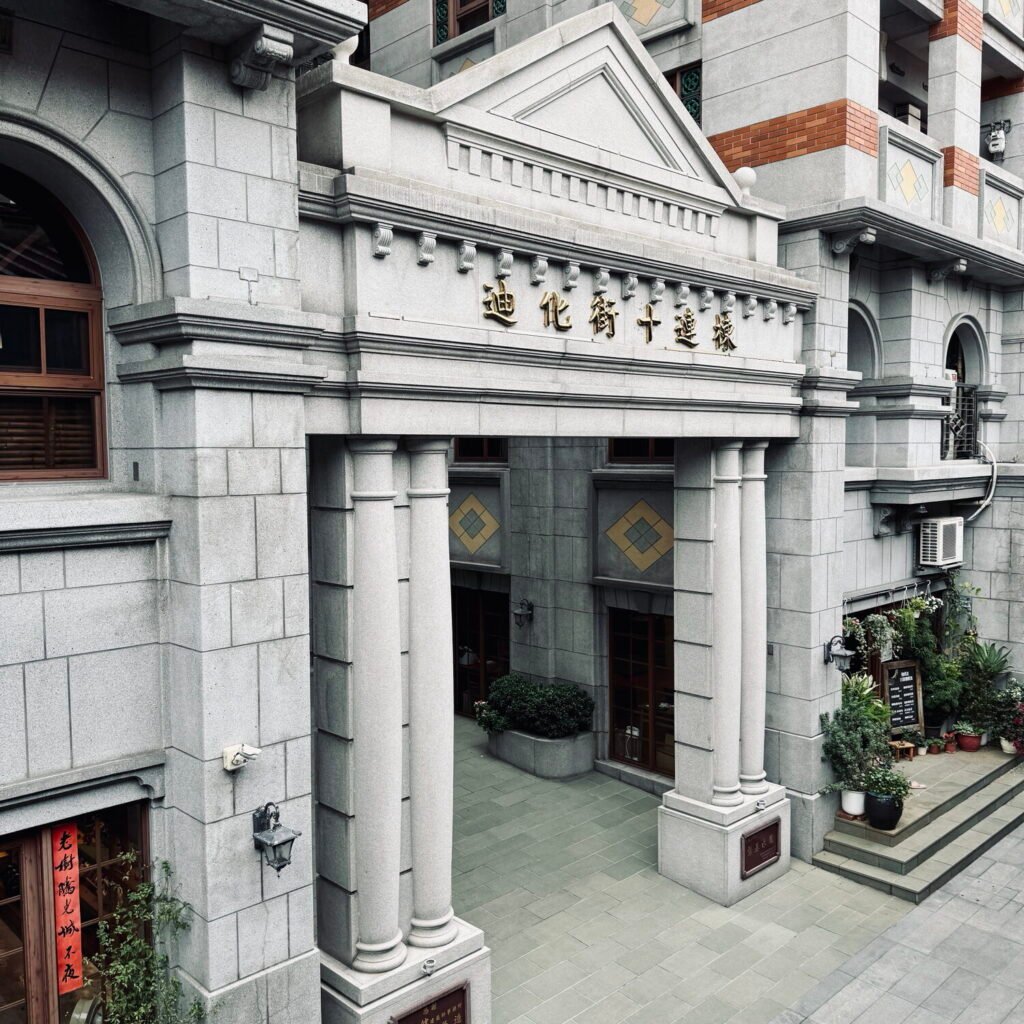
The former📍Renan Hospital (仁安醫院) offered a fascinating glimpse into early modern medicine in Taiwan. As one of Taiwan’s 100 Historical Buildings, its well-preserved rooms and vintage medical equipment tell the story of healthcare’s evolution over the past century.
Our final stop before dinner was📍Dadaocheng Cisheng Temple (大稻埕慈聖宮天上聖母), a stunning traditional architecture with intricate details. The temple also holds historical significance, serving as a cherished cultural hub for the community. Our friend shared that in the mornings, the area comes alive with bustling breakfast stalls, making it a popular spot for locals to eat and socialize.
Mental note: Return for an early visit someday to experience the vibrant morning food scene at Cisheng Temple firsthand.

Evening Feast at NingXia Night Market
⏰ 5:30 PM – 7:30 PM (Day 1)
We timed our arrival at📍NingXia Night Market (寧夏夜市) just as vendors were setting up but before the main crowds arrived. This is my friend’s go-to night market in Taipei, just 10-15 minutes walk from Dadaocheng or MRT stations.

The market is packed with seriously good food! Our feast began at Fang Jia Chicken Rice (方家雞肉飯), where seemingly simple chicken rice revealed complex layers of flavor. Their braised tofu, too, proved that humble ingredients can become extraordinary in the right hands.
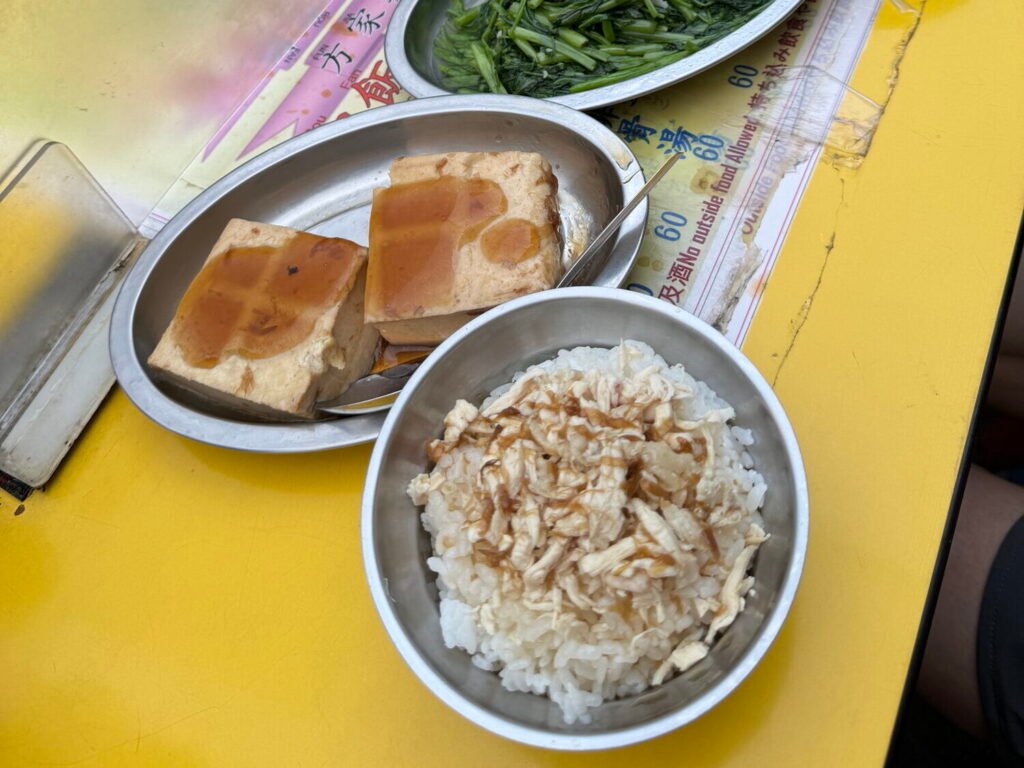
We followed this with Lai Ji’s oyster omelet (賴雞蛋蚵仔煎), which featured fresh oysters wrapped in a perfectly fried omelet that was crispy on the outside and chewy on the inside. The sauce was a bit sweet for my taste, as I typically prefer a savory profile. However, my friend and partner enjoyed it a lot. Overall, it was a great try!
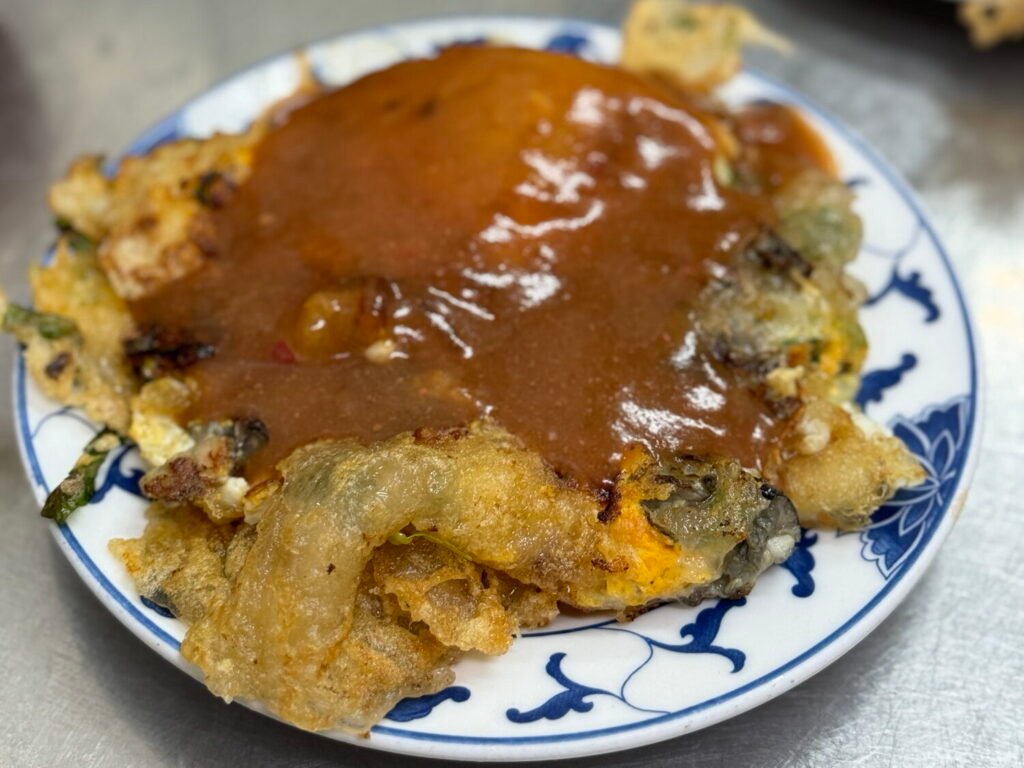
Fun Fun G‘s chicken cutlet delivered exactly what its name promised – pure fun in the form of a massive, perfectly fried cutlet with your choice of seasonings. We opted for the traditional pepper salt, and it didn’t disappoint.
Our next stop is Zhan Fruit (詹記水果), a fruit stall that has been operating for over 30 years. It offers a variety of seasonable fruits such as pineapple and guava, freshly cut to order. We tried its signature ginger soy tomato, a traditional flavor that my friend grew up eating but is hard to find elsewhere in Taipei nowadays. The special ginger dipping sauce has a unique sweet and savory flavor, making it a refreshing stop after night market snacks.
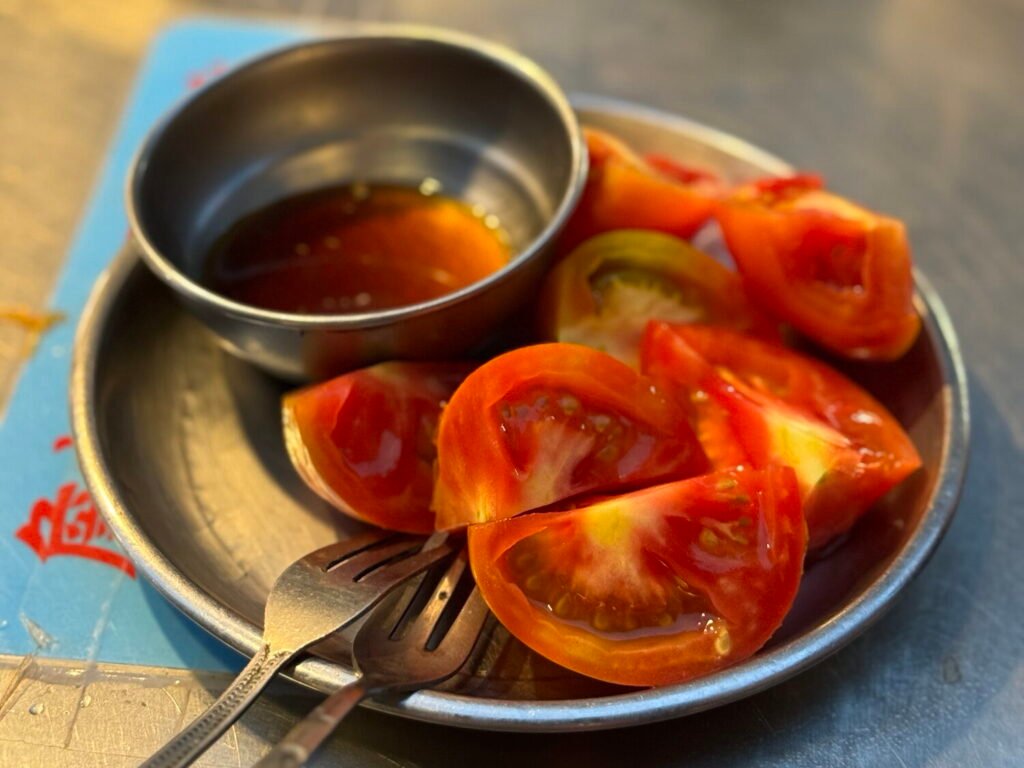
We ended our NingXia Night Market food adventure at Beans Village (豆花莊), where their signature tofu pudding with brown sugar tapioca jelly and taro balls offered our evening a light, sweet finish.
Fun Fact: Jensen Huang, Nvidia’s CEO, visited the same spot a week after us!
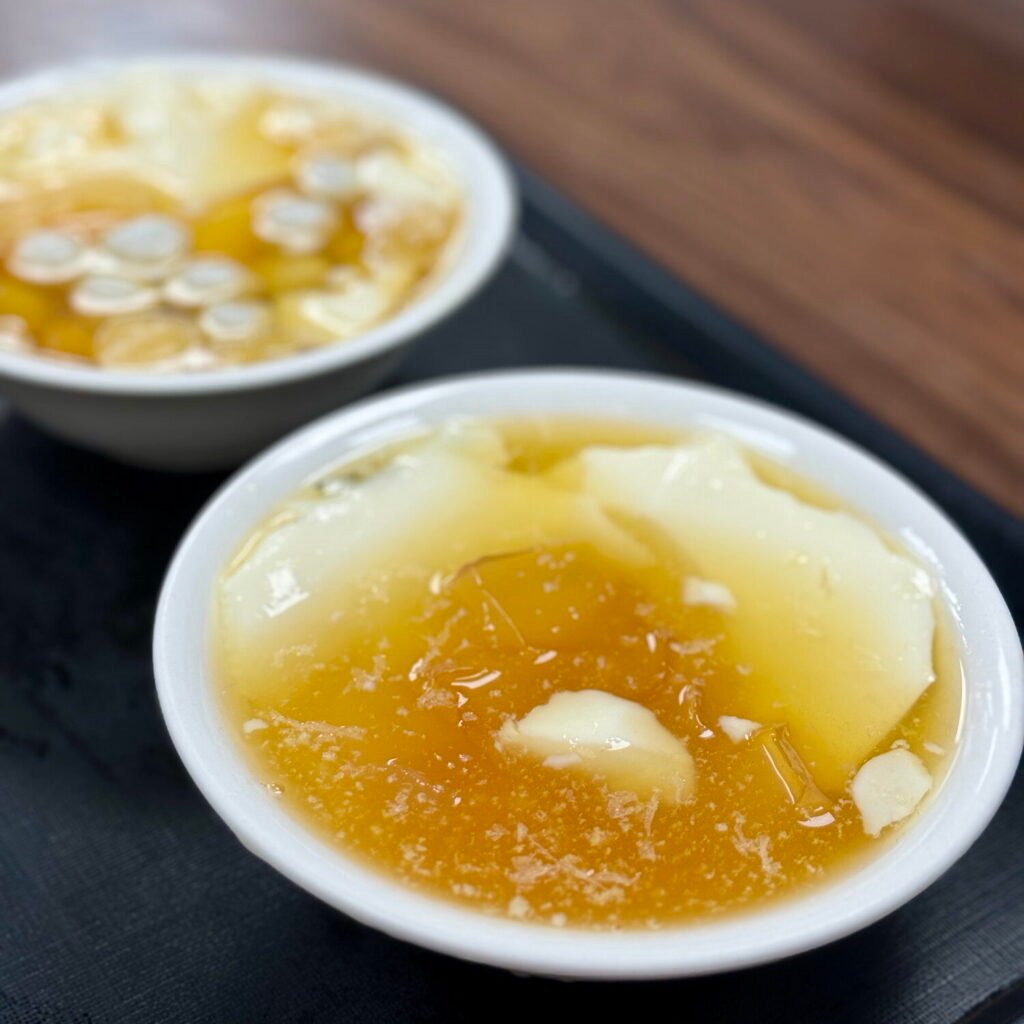
Tips for Getting Around on Taipei Day1:
Start your day at Ximen MRT Station (西門站) on the Blue or Green Line and end near Shuanglian Station (雙連站) on the Red Line or Zhongshan MRT Station (中山站) on the Red or Green Line. Most attractions on today’s itinerary are within walking distance, with occasional bus options for longer stretches if preferred. For real-time route planning and updates, Google Maps is an excellent tool to guide you throughout the day.
Day 2: Mountain Views and Cultural Treasures
Elephant Mountain Hike
⏰ 9:00 AM – 12:00 PM (Day 2)
We started today with a hike at📍Elephant Mountain (象山) to battle our jet lag. This is a popular spot for viewing Taipei 101, Taiwan’s tallest skyscraper and an icon of Taipei City. The trailhead is easily accessible by bus or MTR. We chose to take the bus from our hotel to see the city wake up.

We ascended a series of steep stone steps. In Taipei’s signature summer heat, the humid air wrapped around us like a blanket. Fortunately, the trail was relatively well-shaded, and there were plenty of resting spots along the way where we could catch our breath. About halfway through, we started to have increasingly spectacular views of the city below, which added to our excitement.
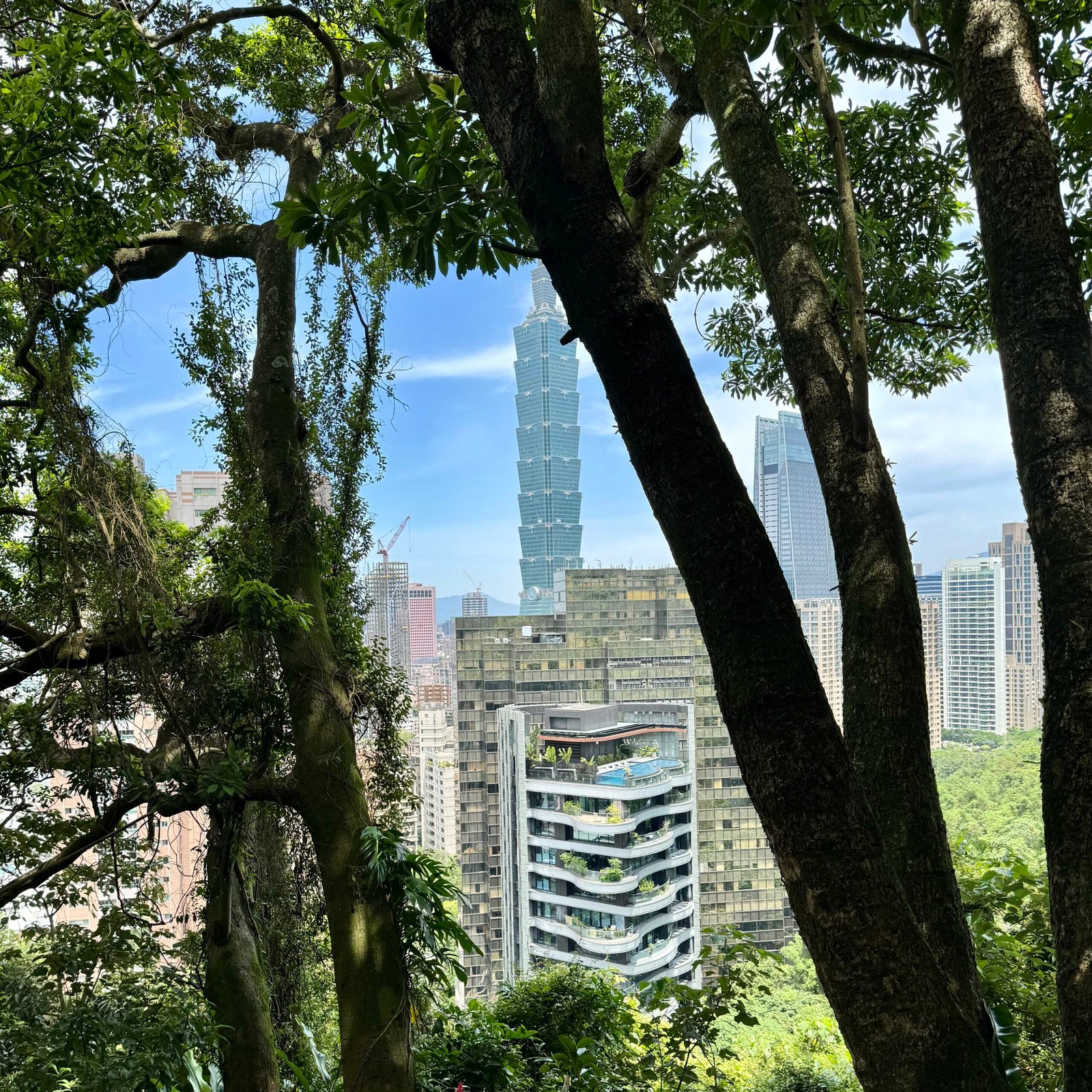
Roughly 20-25 minutes later, we reached the summit viewing platform. There stood Taipei 101, piercing Taipei’s cityscape proudly. The morning breeze dried our sweat as we took in the sprawling metropolis below.

We took our time with photos and enjoying the view. Then, we spontaneously decided to follow a quiet trail to📍Si Beast Mountain (獅山峰). En route, we visited📍Beixingbao Palace (北星寶宮), a very beautiful temple nested in the forest. There were barely any other travelers on this part of the trail. We enjoyed the mountain’s natural rhythm all to ourselves and paid our prayers before heading back down.
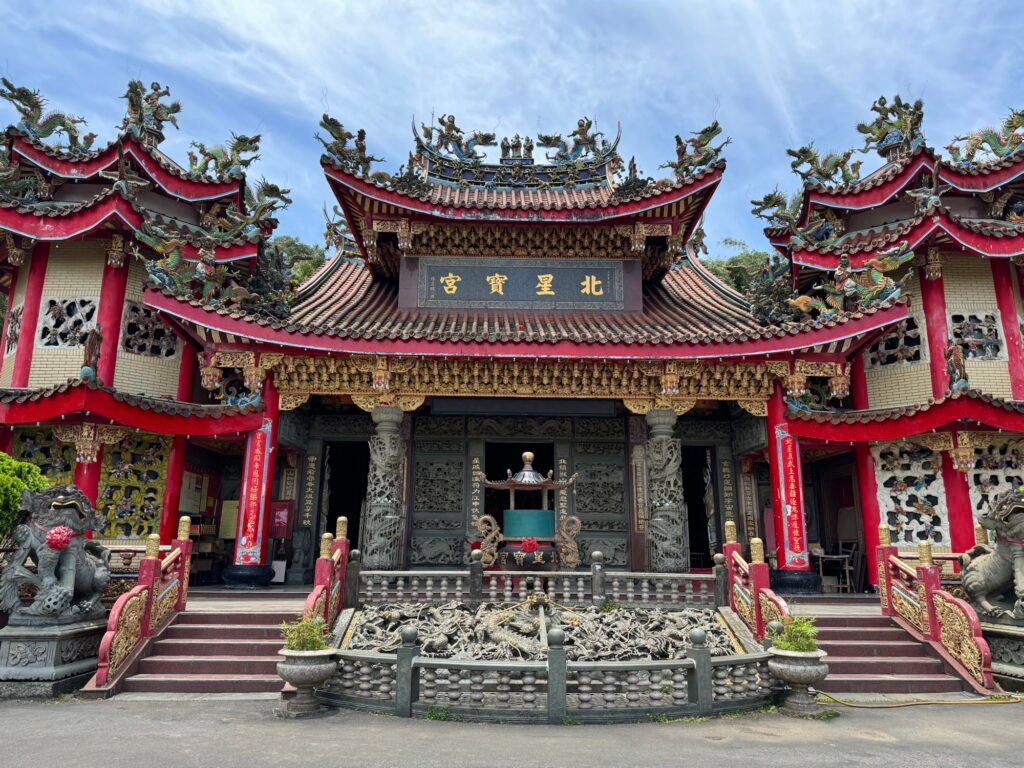
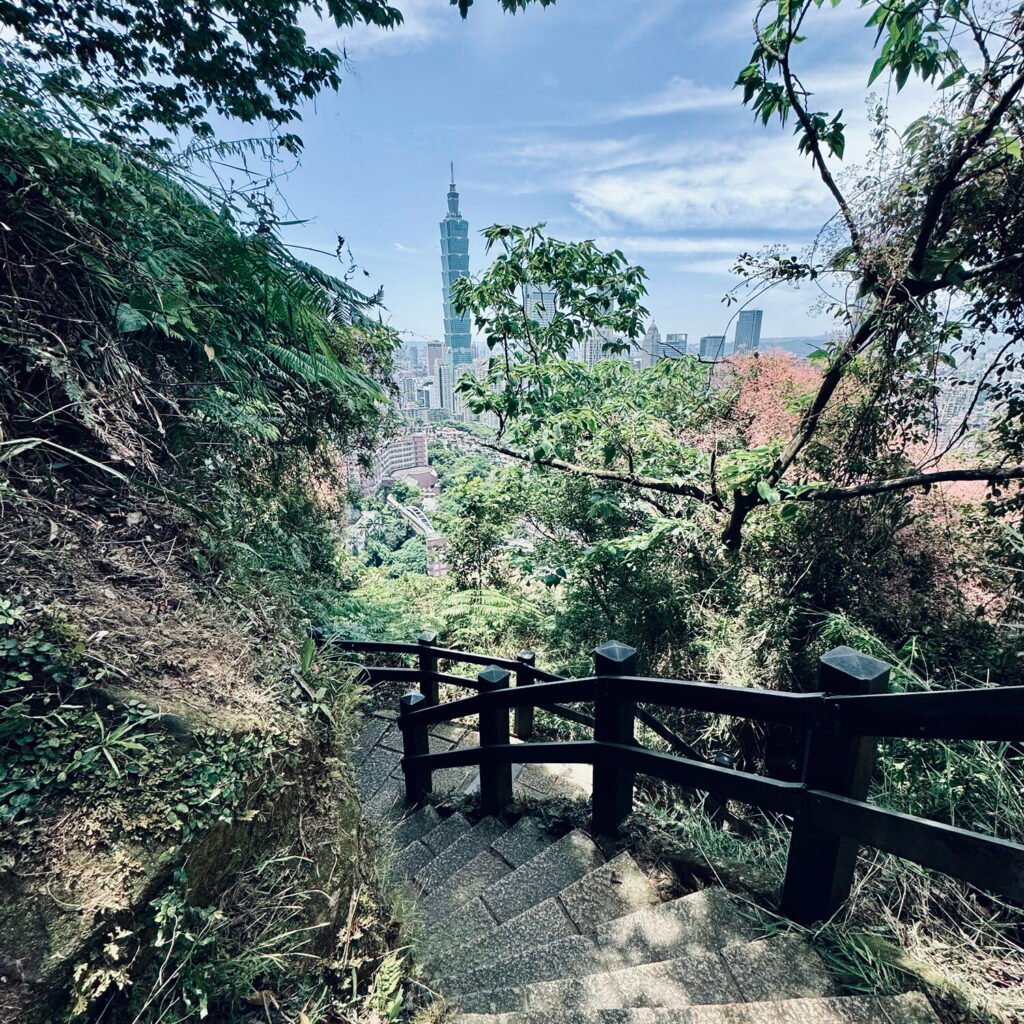
A Well-Earned Lunch
⏰ 12:00 PM – 1:00 PM (Day 2)
Hungry from the hike, we found📍Lao Qiu Beef Noodle Restaurant (老邱牛肉麵), a small noodle shop near the Elephant Mountain trailhead. We ordered its signature beef noodle soup (牛肉麵) and a few side dishes. The beef noodle soup arrived steaming. The broth was rich and aromatic. The beef was tender and tasty. The noodles were perfectly chewy, and we especially enjoyed the thick noodles. The side dishes was simple yet savory. It was exactly the post-hike feast that we had craved.

Treasures at the National Palace Museum
⏰ 1:00 PM – 5:00 PM (Day 2)
The📍National Palace Museum (國立故宮博物院) houses one of the world’s finest collections of Chinese art and artifacts. We were in particular interested in its two infamous pieces- the “Meat-shaped Stone” (肉形石) and the “Jadeite Cabbage” (翠玉白菜). The “meat-shaped stone” is a piece of jasper, carved and colored to perfectly mimic a piece of braised pork belly. Its craftsmanship is so precise that it had us craving actual braised pork belly. Unfortunately, the “Jadeite Cabbage” was away on tour, so I guess another reason for us to return to Taipei someday.
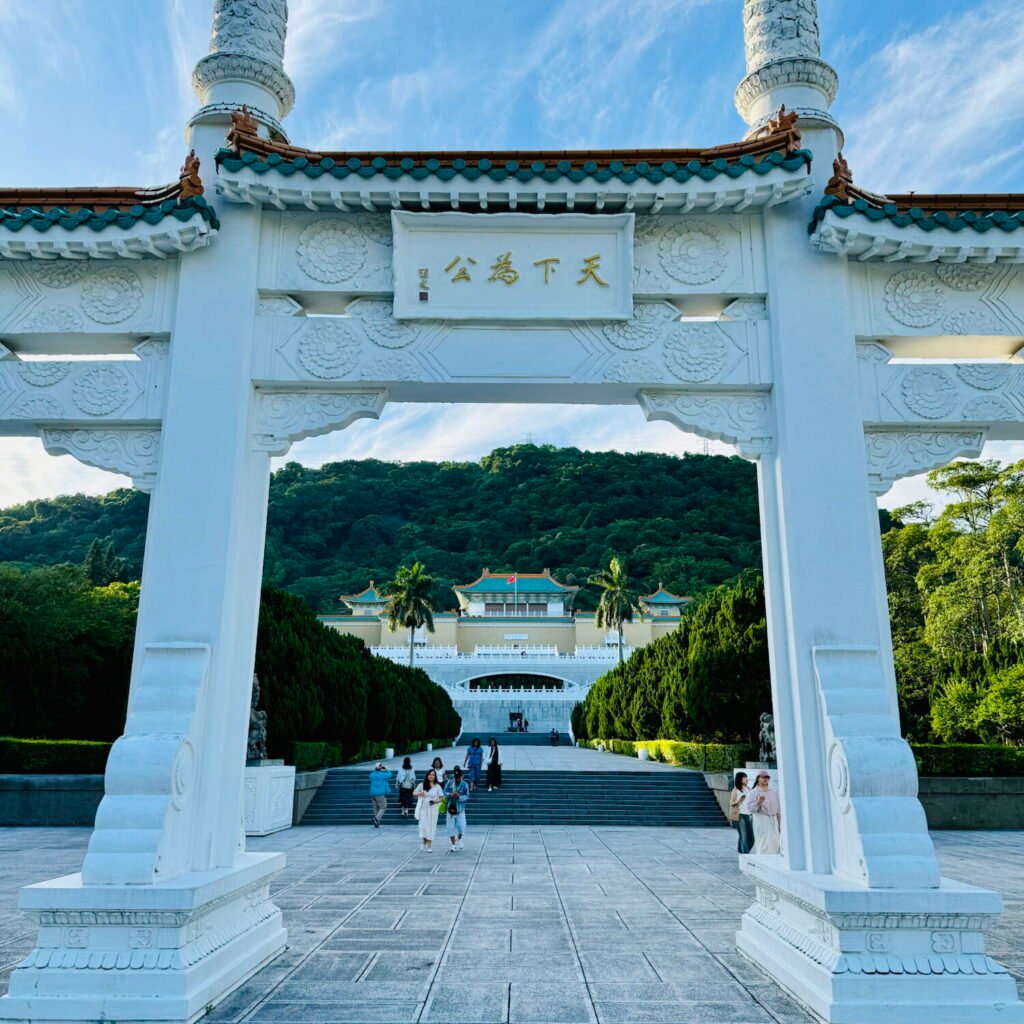
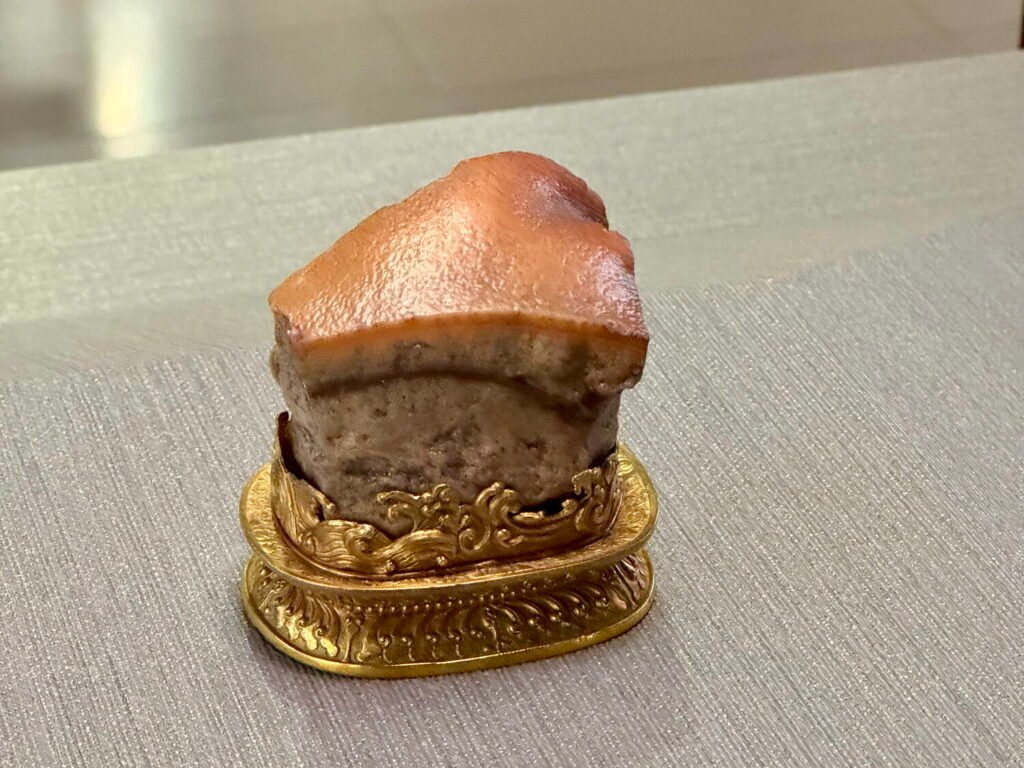
Books and Crafts
⏰ 5:00 PM – 7:00 PM (Day 2)
A visit to Taipei is not complete until you visit📍Eslite Spectrum (誠品生活). This bookstore chain in Taiwan not only has a vast collection of books but also sells unique lifestyle crafts, stationery, vinyl, perfumes, clothes, etc. The atmosphere there was super cozy. Before we realized it, we spent hours wandering through its carefully curated sections and enjoying a glimpse of contemporary Taiwanese culture and creativity.
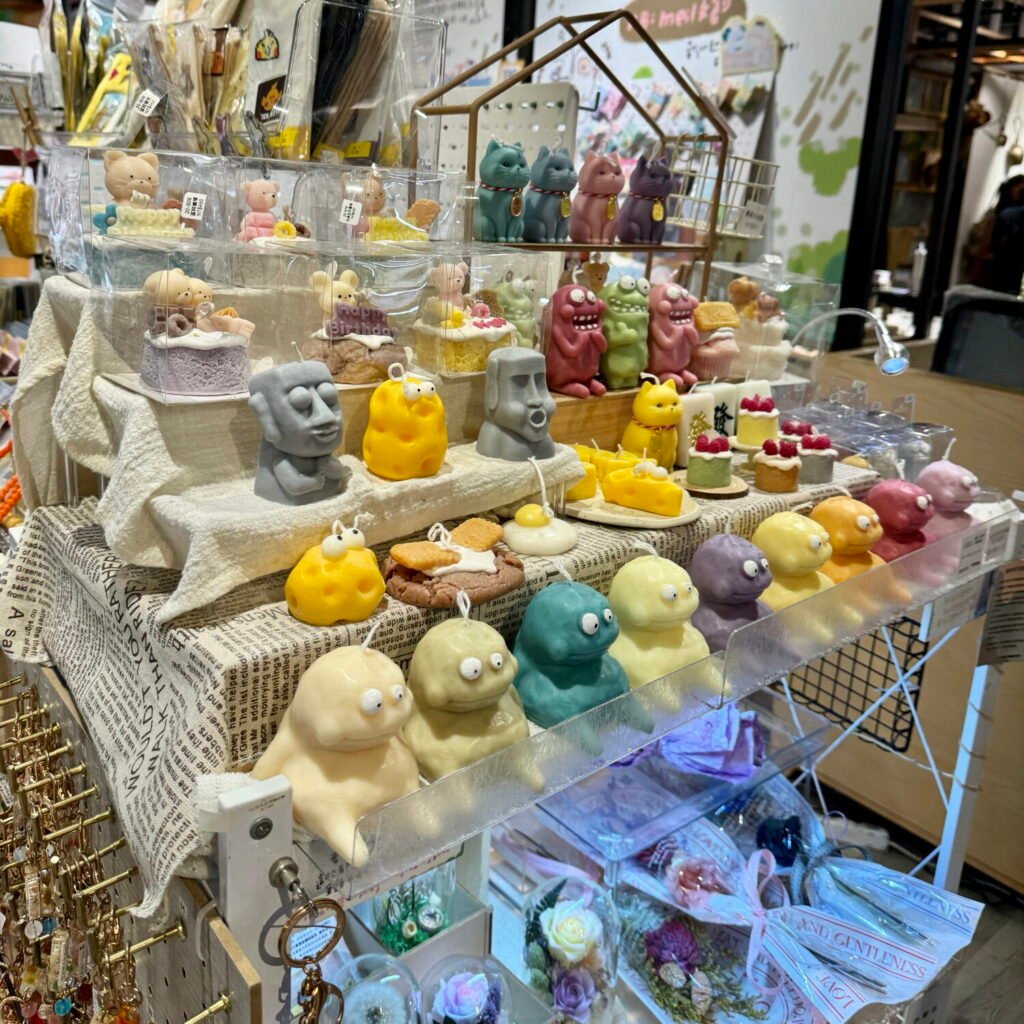
Evening Wind Down
⏰ 7:00 PM – 9:00 PM (Day 2)
We ended our day at📍Taiwan Bistro (阿薄郎台式小酒館), a modern izakaya chain with a few spots in the heart of Taipei. We sampled an array of skewers (串燒) and dumplings (水餃). The casual atmosphere was perfect for our tired bodies. Most dishes were served on small plates and arrived in a steady rhythm. We enjoyed the delicious food at our own pace and let the day’s memories settle alongside our meal.
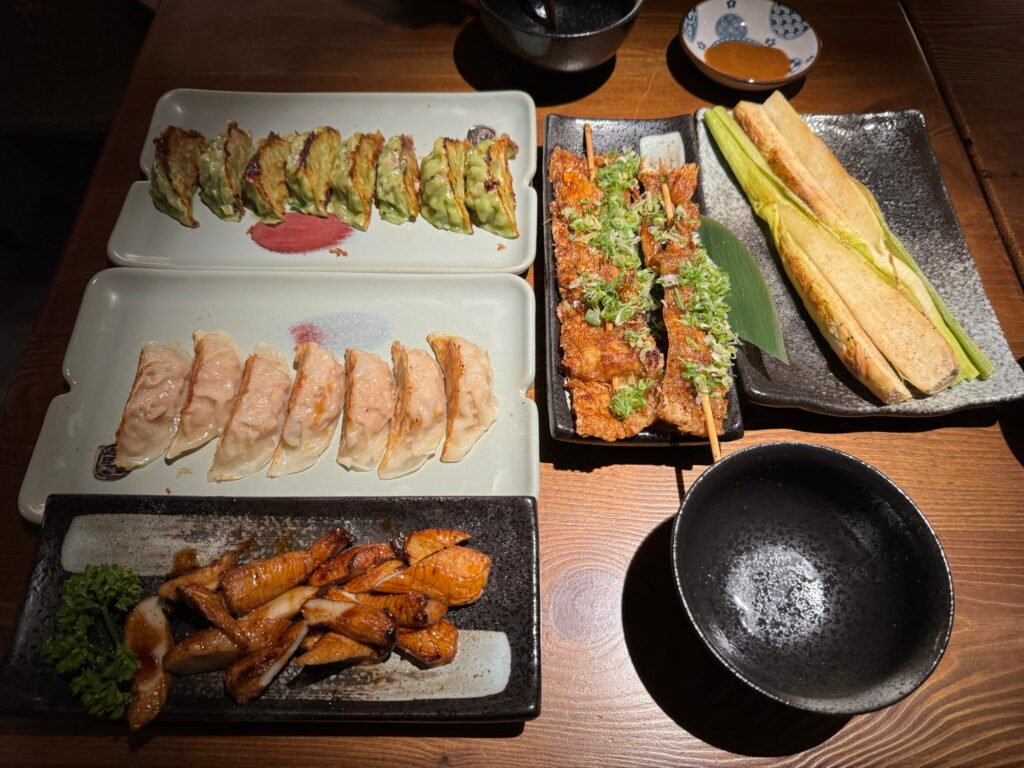
Travel Notes for Taipei Day 2:
- Elephant Mountain trails are well-marked and maintained. Try to have an early start- that will help beat both heat and crowds.
- We highly recommend renting an audio guide at the National Palace Museum—it will significantly enhance your experience. The audio guides are available in various languages, and the museum staff will help you set them up properly.
Day 3: Tea and Tranquility in Maokong and Taipei Grand Hike
Growing up, there was one Taiwanese talk show that I loved watching – it’s where I first learned about the wonders of Maokong (貓空), Taipei’s renowned tea capital. The hosts talked about spending leisurely afternoons sipping tea with friends at the mountain’s historic teahouses, and I’d longed to experience that myself ever since.
Today, we set out to make that dream a reality, combining our Maokong tea pilgrimage with a hike through part of the scenic Taipei Grand Trail, Section Seven (臺北大縱走).
Head to Maokong Gondola and A Fun Ride
⏰ 9:30 AM – 11:30 AM (Day 3)
We began our day with an MRT ride to📍Taipei Zoo Station (動物園站), then walked to the boarding area of Maokong Gondola‘s Taipei Zoo station. There are two types of cabins you can ride- the Regular Cabin with steel floors or the Crystal Cabin with glass floors. Only about every third or fourth cabin is a Crystal Cabin. This means that typically it’ll take much more time to queue for a Crystal Cabin even if the line for it looks shorter. We opted for the Regular Cabin to avoid a longer waiting time, and we were happily satisfied about the experience! The ride soared over forested ravines, giving us a tantalizing preview of the day’s adventures.

After roughly 10-15 minutes gondola ride, we got off at📍Zhinan Temple Station (貓空纜車指南宮站). This is the second stop after Taipei Zoo station and is about halfway of the entire Maokong gondola ride. We planned to hike up to Maokong from here via the Taipei Grand Trail, Section 7.

Explore Zhinan Temple
⏰ 11:30 AM – 12:30 PM (Day 3)
Before tackling the hike, we first spent time exploring the📍Zhinan Temple complex (指南宮). Also known as the “the Temple of a Thousand Steps“, this Taoist complex features three main shrines: Lingxiao Temple (凌霄寶殿), Chunyang Temple (純陽寶殿), and Daxiong Temple (大雄寶殿).

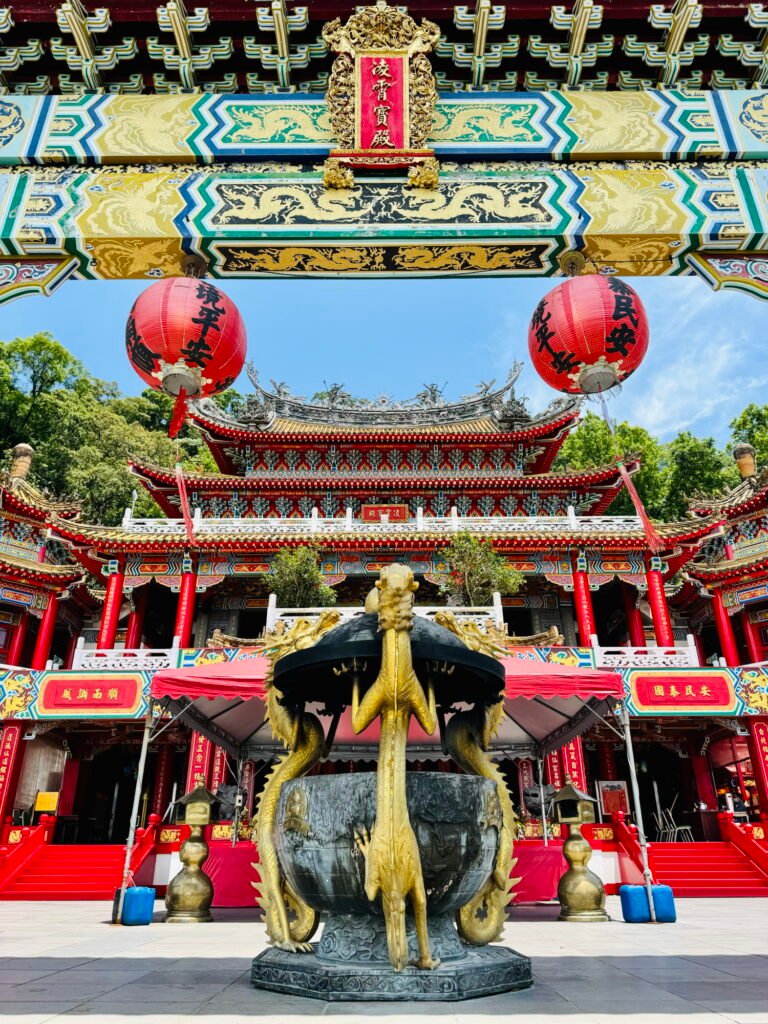
As we wandered the temple grounds, we marveled at the sheer scale and intricate details of these structures. Ornate roofs, carved dragons, and vibrant colors created a striking visual feast against the lush green backdrop of the surrounding forest. You could almost feel the weight of history and spirituality emanating from these hallowed halls.

We took our time to appreciate the tranquility of the temple. Feeling calm and energized, it was time to embark on the next phase of our adventure – tackling the Maokong Hike!
Hike the Taipei Grand Trail, Section 7
⏰ 12:30 PM – 2:00 PM (Day 3)
The hike could be roughly divided into two big legs with a few shorter unnamed connections in between: Dacheng Temple Trail (大成殿步道) -> Tea Promotion Center Trail (茶推廣中心步道). You can see the detailed hiking route highlighted in the red line on the trail map below.
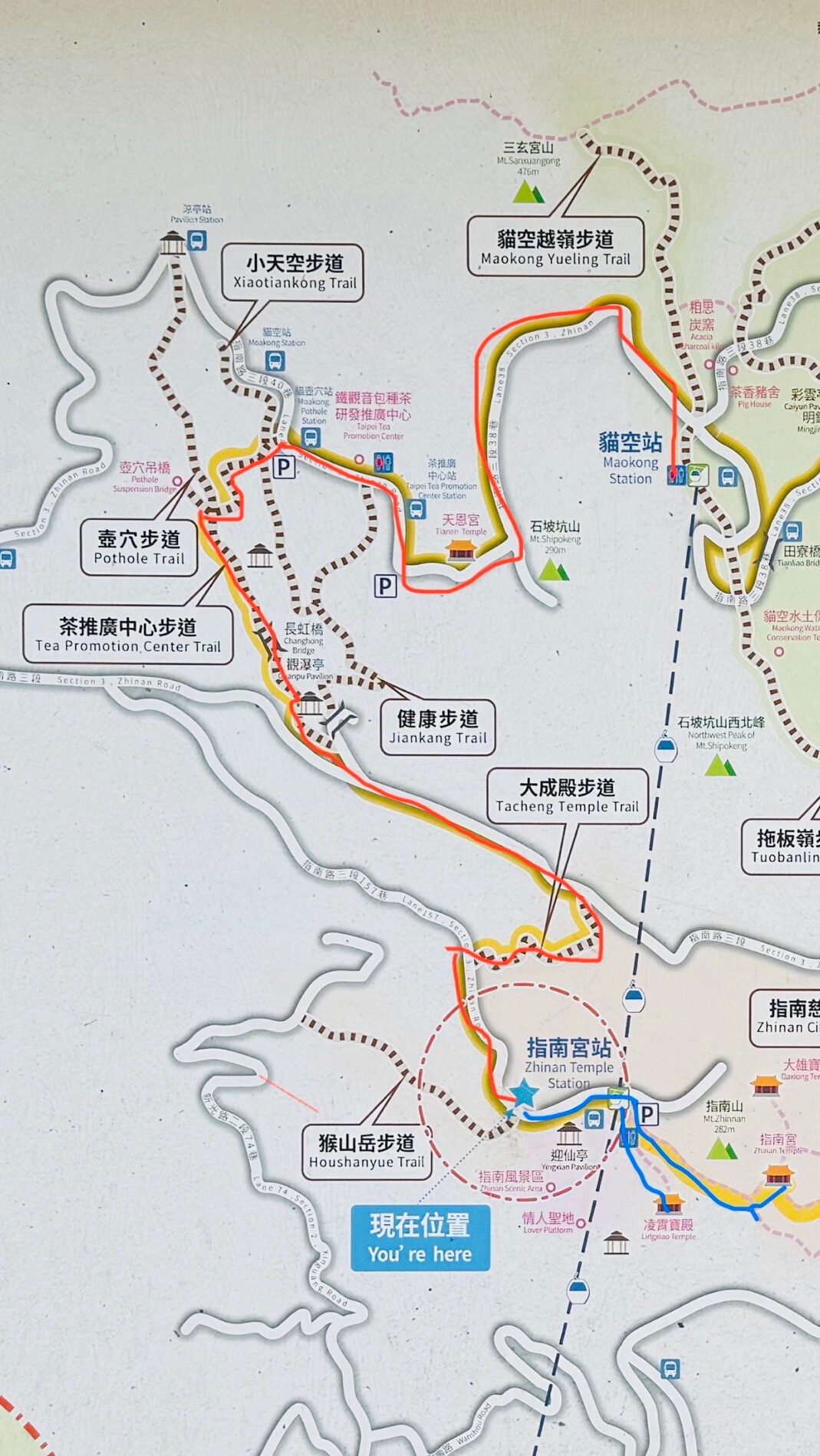
The initial📍Dacheng Temple Trail (大成殿步道) proved to be the most challenging. The path was steep and uneven as we descended into a dense forest, with each step requiring careful navigation. At times, we even questioned whether we were still heading the right way, as there were few clear trail markers and we were the only hikers on the path.

Just when we were about to give up, the trail opened up to a paved road. The road led us to a crossroad shortly after, where we met two cute cat sculptures taking selfies. We joined them (yay!), took a selfie ourselves and continued onto the second leg of the hike.
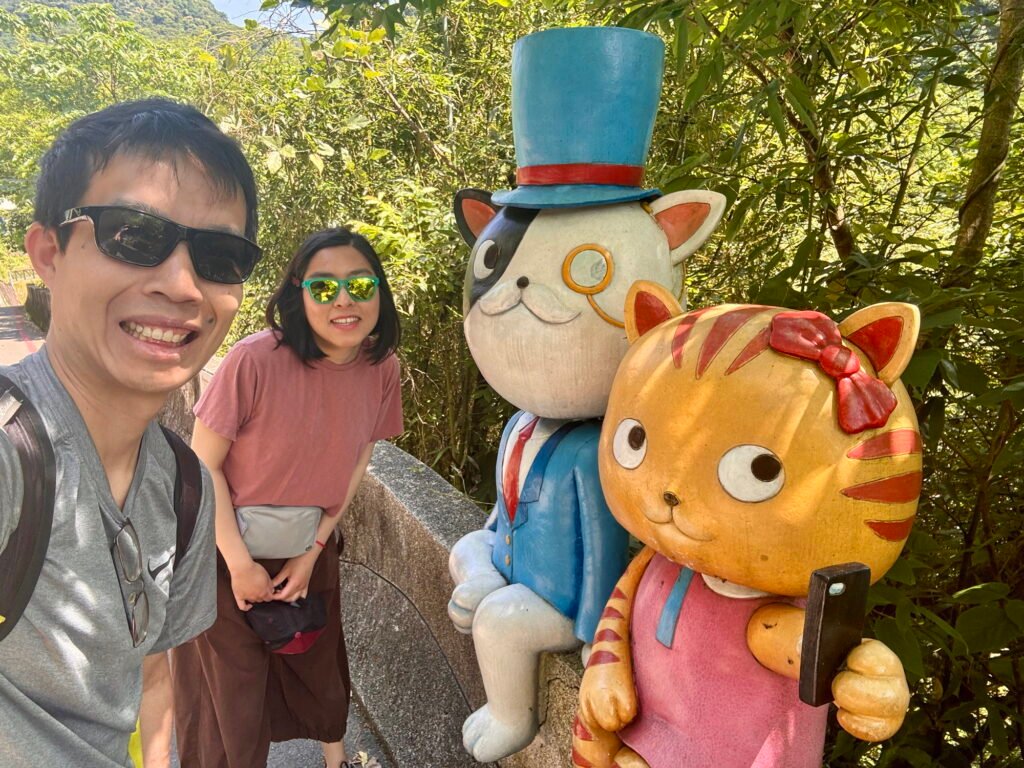
This second leg,📍Tea Promotion Center Trail (茶推廣中心步道), was a delightful workout. After passing a beautiful waterfall, we hiked up a serious amount of steep wooden stairs and flat boardwalks, winding through the heart of Maokong’s verdant fields. As we got higher up, we started to have breathtaking views of Maokong’s renowned tea plantation.


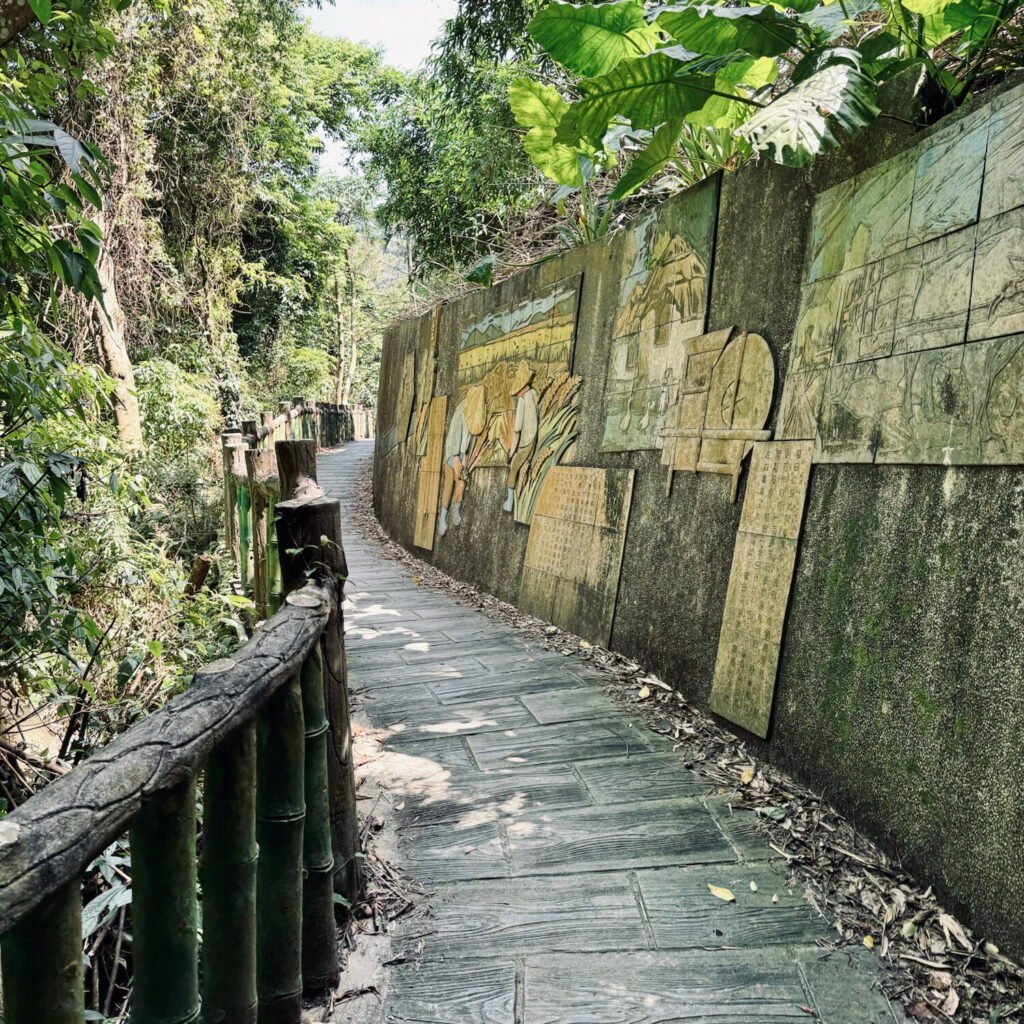

A Restorative Teahouse Interlude
⏰ 2:00 PM – 3:30 PM (Day 3)
Approaching the Maokong Gondola station, we gratefully settled into a local teahouse called📍Big Tea Pot (阿義師的大茶壺茶餐廳) for a well-deserved lunch. The two-person set menu we ordered featured an array of dishes infused with the rich, fragrant notes of Tieguanyin tea (鐵觀音茶), a type of oolong tea that Maokong is most notably known for.

As we savored each course on the breezy patio, gazing out at Maokong’s lush forests close up and Taipei’s skyline in the distance, a profound sense of contentment washed over us. The rhythmic sipping of tea, the gentle mountain breeze, the simple but expertly prepared local fare – it was as if time had slowed to a near-stop, allowing us to fully immerse ourselves in the present moment.
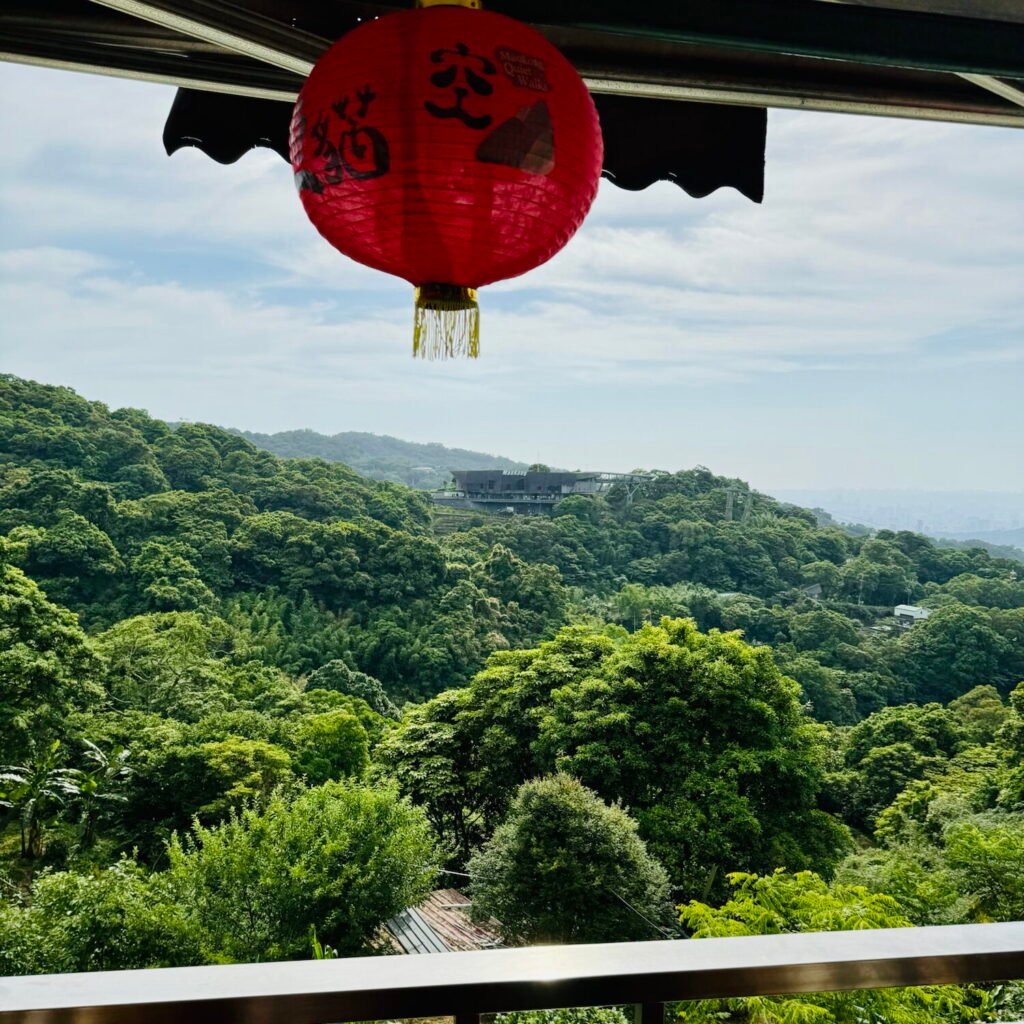
Explore Maokong’s Charms
⏰ 3:30 PM – 5:00 PM (Day 3)
After our restorative lunch, we spent the afternoon wandering Maokong’s charming streets and cafe hopping for tea-flavored soft-serve ice cream. The pace was leisurely, perfect for digesting both our meal and the day’s experiences so far.
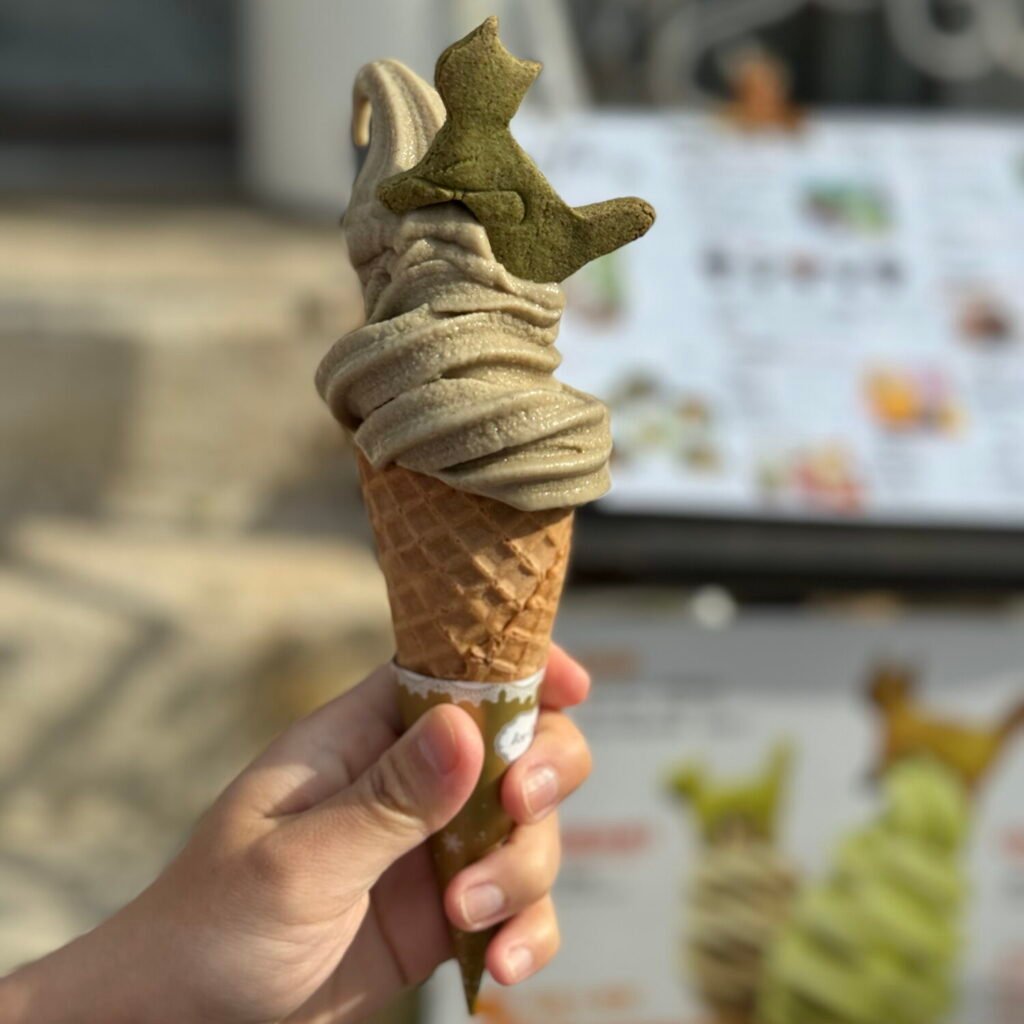
Eventually, as the afternoon shadows grew longer, we started to make our way back towards the city center. As we waited for our ride back to Taipei Zoo Station, we were filled with gratitude for the perfect balance of activity and tranquility that defined our Maokong adventure.

Tips for extending your time at Maokong and returning to the city center:
- There are a few other short trails and many shops to explore near Maokong Station, so if you prefer, you can easily extend your time at Maokong to the evening, have dinner and enjoy the night view before you head back. Two of the most recommended short hikes near Maokong Station are Camphor Tree Trail (樟樹步道, easy, <20 mins round way) and Silver Stream Cave Trail (銀河洞, moderately challenging, 1-3 hours depending on fitness level).
- On our way from Maokong Station to Taipei Zoo Station, we took the bus instead of the gondola. The buses are faster and cheaper than the gondolas and often don’t require as long a wait. The downside is that they are not as scenic as the gondolas. Once you reach Taipei Zoo Station, you can transfer to the MRT to reach your final destination.
Return to Taipei City Center with New Appreciation, Dinner and Wind Down
⏰ 5:00 PM – 8:30 PM (Day 3)
We reunited with our local friend after getting back to Taipei city center. We then capped off the day with a celebratory dinner at📍Shin Yeh Taiwanese Cuisine (欣葉台菜), one of Taipei’s most beloved Taiwanese restaurant chains for family celebrations and treating visiting friends. The dining environment reminded me of an upscale Cantonese dim sum place – spacious, bright, lively, and comfortable. We feasted on classics like fried pig liver (香煎豬肝), fried fragrant turnip omelette (菜脯蛋), seasonal leafy green vegetables (炒季節時蔬) and stir-fried squid in 3 cups sauce (三杯中卷), paired with its signature porridge with sweet potato (地瓜白粥). Every dish looked so simple but tasted so great, giving me the comforting warmth of home-cooked meals and the finesse of professional cooking at the same time.
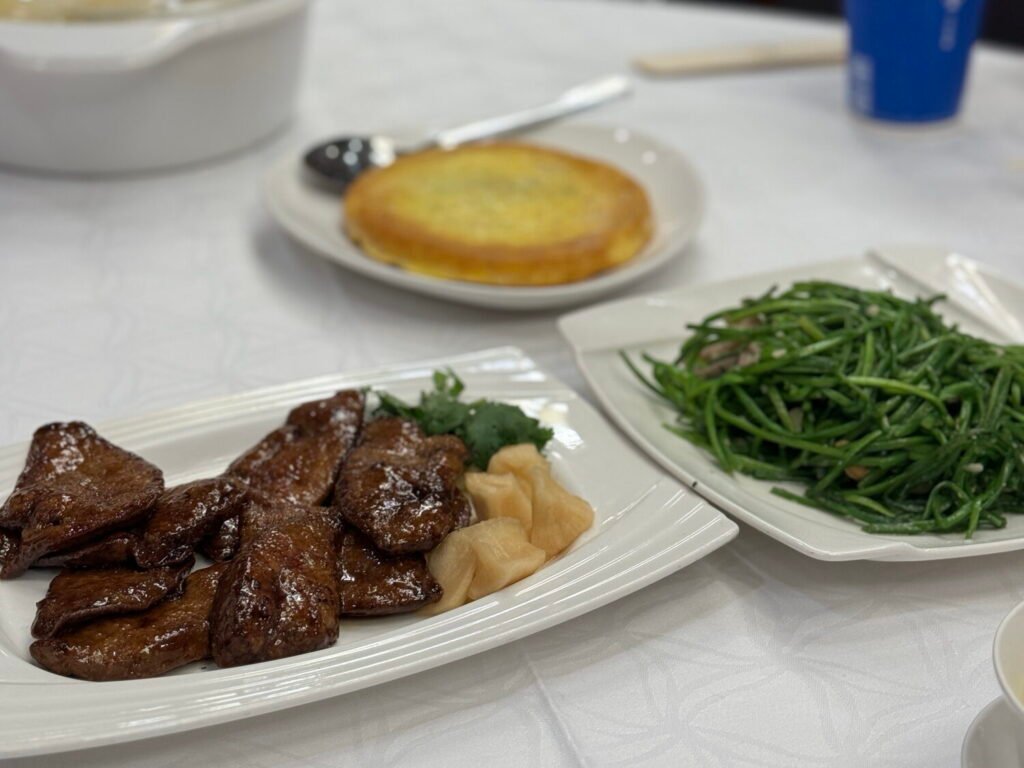
We savored every bite while sharing stories of the day’s adventures. It was the perfect way to bid farewell to today’s enchanting mountain retreat, our senses and souls nourished by the experience.
Practical Tips for Taipei Day 3:
- Arrive early at the Maokong Gondola to beat the crowds and secure your preferred gondola type
- Pack snacks and water for the Taipei Grand Hike, as the trails can be strenuous in Taipei’s summer heat
- Don’t rush your time at the teahouse – truly savor the experience of sipping fragrant teas and indulging in local delicacies
- Leave room in your itinerary to wander Maokong’s charming streets and stop for tea-infused treats
- Make reservations in advance at Shin Yeh to avoid the wait (typically 1+ hours at peak dining time).
Day 4: Culture, Creativity and Culinary Delights
A Legendary Taiwanese Breakfast at Fuhang Soy Milk
⏰ 8:00 AM – 9:30 AM (Day 4)
We kicked off the day with another hearty Taiwanese breakfast, this time at the renowned📍Fuhang Soy Milk (阜杭豆漿)—one of Taipei’s most famous traditional breakfast spots, recognized by the Michelin Bib Gourmand for multiple years.
Tucked away on the second floor of Huashan Market (華山市場), Fuhang was already bustling when we arrived. The line stretched down the stairs and wrapped around the corner, a normal scene for Fuhang. Surprisingly, the wait was quite enjoyable. Our friend advised us to be quick, decisive, and specific when ordering, so we used the time to study menu photos, carefully planning our choices to make the most of our limited stomach space.
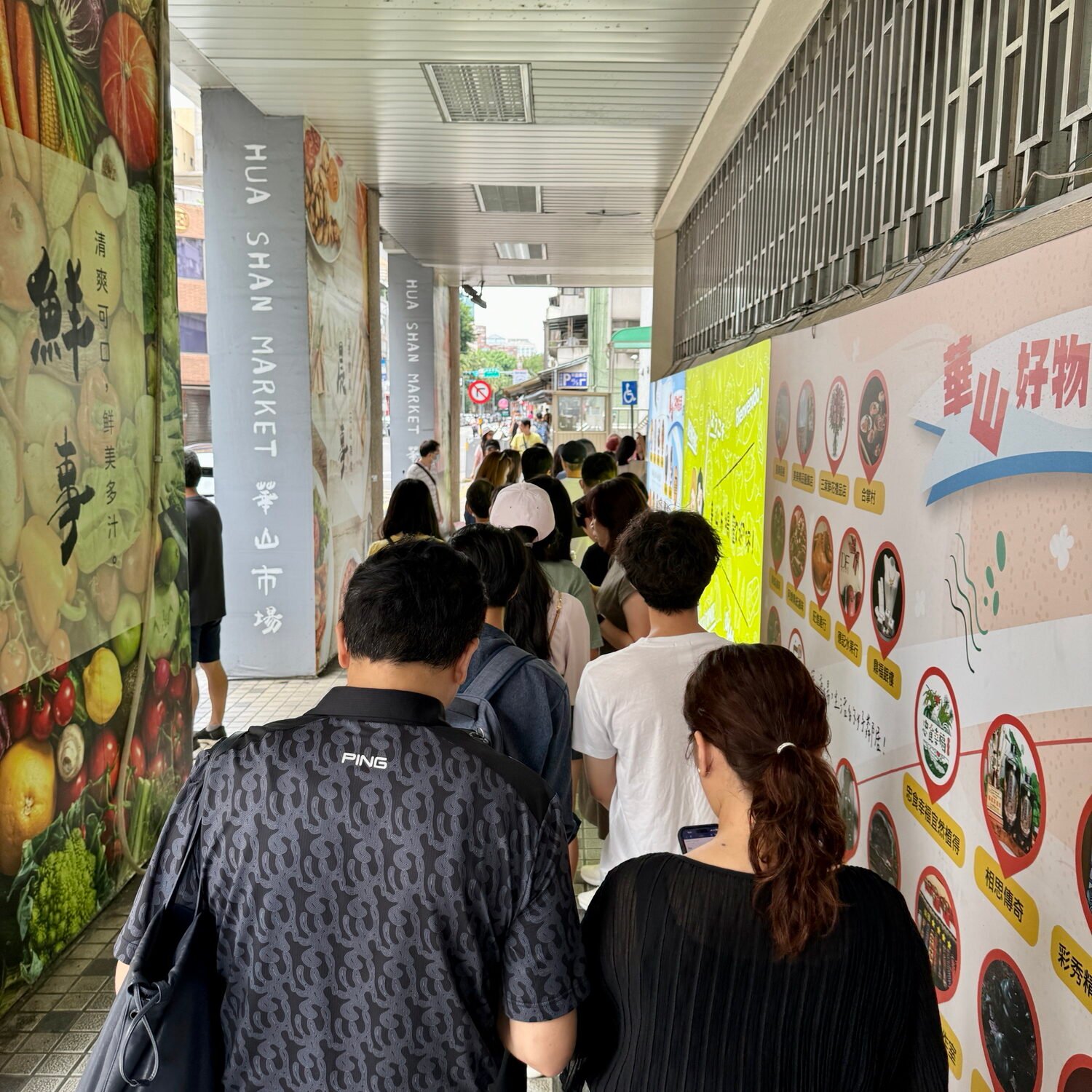
After about 35 minutes, we finally entered the store. From there, the wait became more interesting as we watched the organized chaos of Fuhang’s kitchen through glass windows. It was both fun and mesmerizing—pastry chefs shaping fluffy dough with practiced precision, bakers skillfully handling golden flatbreads inside traditional charcoal stoves, and servers calling out orders in rapid-fire Mandarin. The efficiency and teamwork behind the counter were a spectacle in themselves, making the anticipation for our meal even greater.
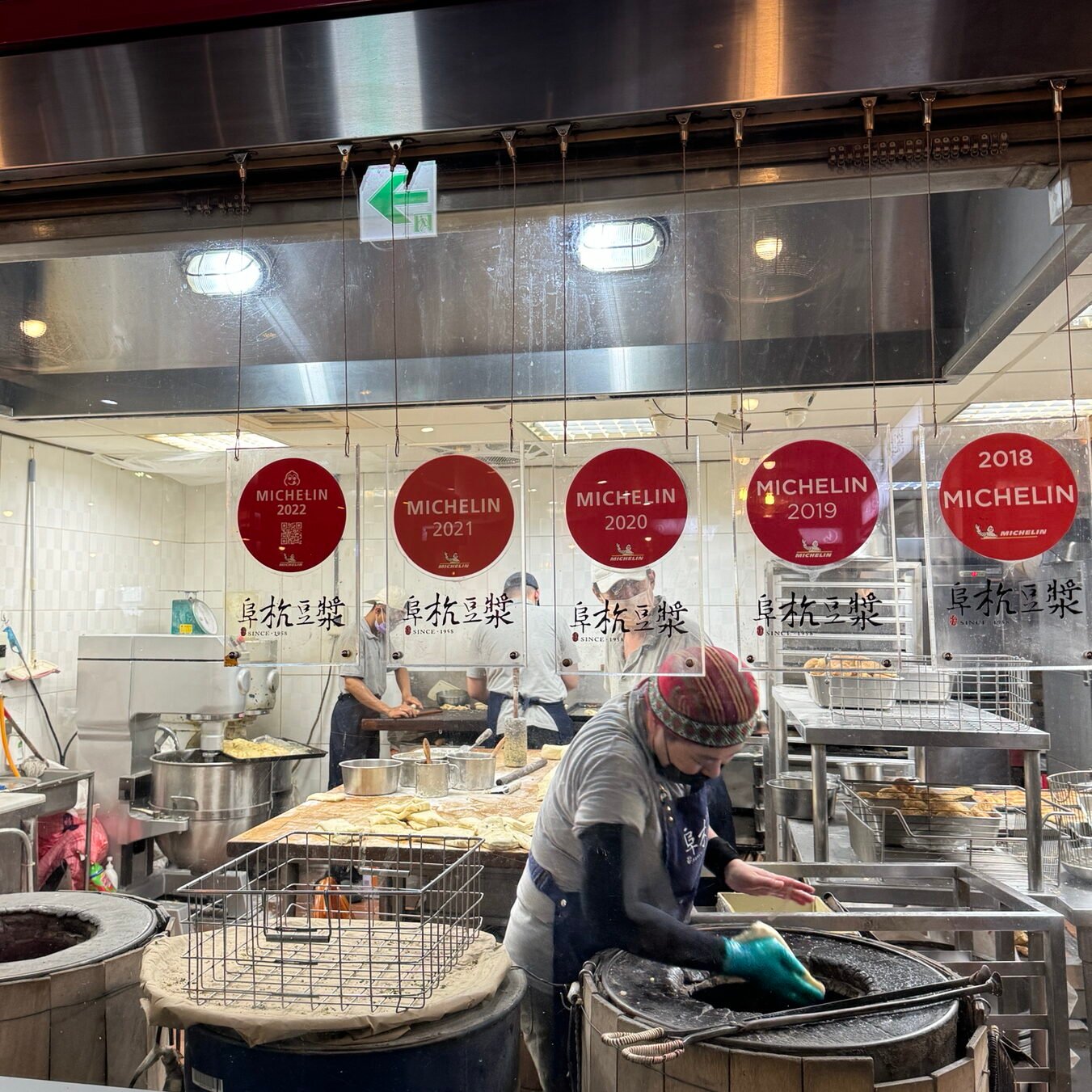
Roughly ten minutes later, we reached the counter and ordered their signature items:
- 😋 Savory soy milk with youtiao (鹹豆漿) – My personal favorite! It reminded me of the savory tofu pudding breakfast dish I grew up eating in northern China. While my partner and friend found it an acquired taste, I loved its rich, layered flavors and the contrast between the silky, egg drop-like soup base and the crispy youtiao.
- 👍 Thick bread with scrambled eggs (厚餅夾蛋) – Charcoal-grilled to perfection, with just the right chew and a subtle smokiness.
- 👍 Soy milk (豆漿) – Smooth, fragrant, and naturally sweet, it was the perfect pairing.
- 👎 Dried daikon bun (蘿蔔絲餅) – The one miss of the meal. It didn’t quite live up to our expectations, and we all agreed we’d probably skip it next time.
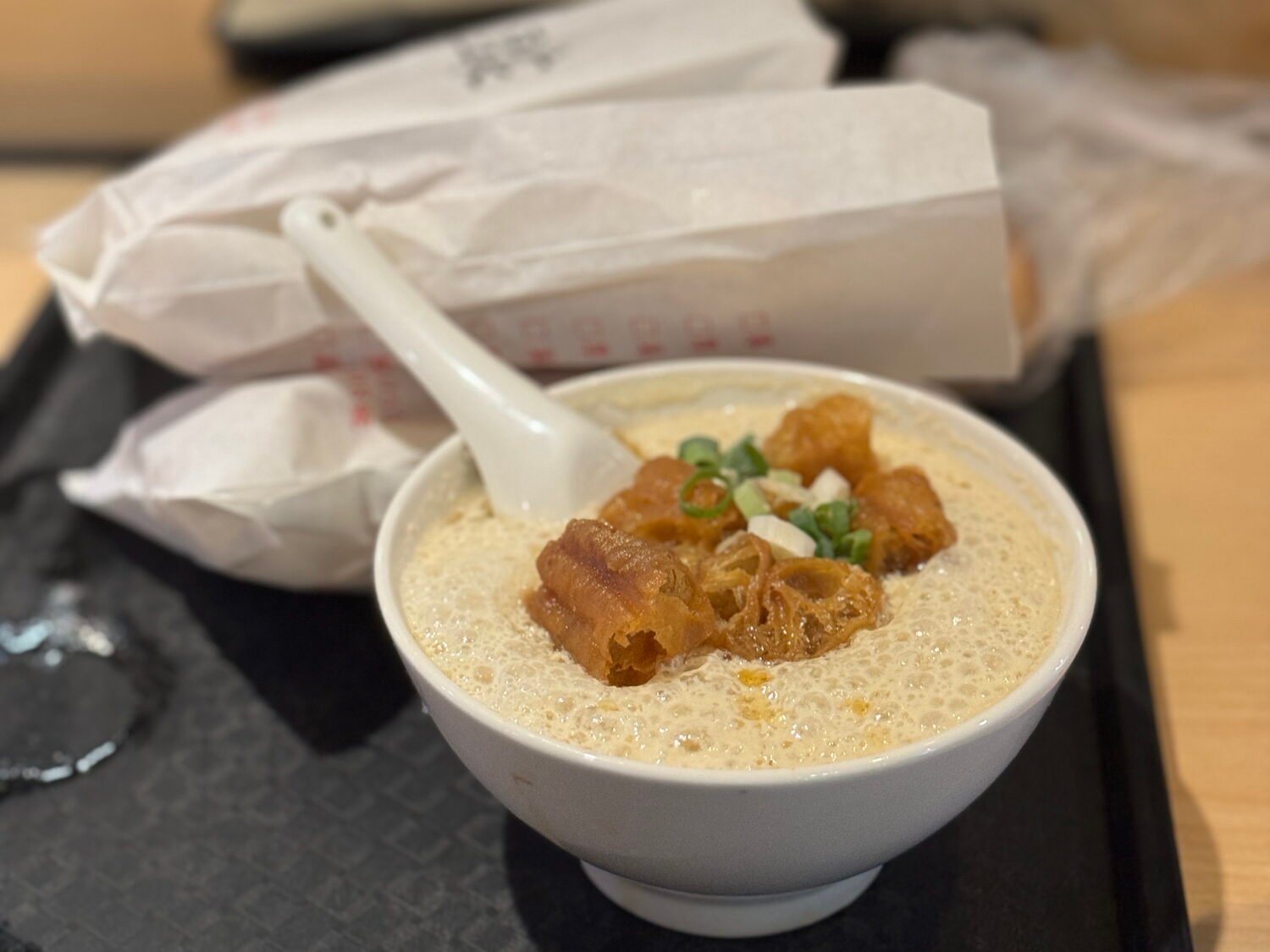

By the time we finished, the line was even longer, proving just how beloved this spot is among locals and visitors alike. Despite the wait, the meal was a highlight—a perfect blend of flavors, nostalgia, and cultural immersion to start the day.
Art and Innovation at Huashan 1914 Creative Park
9:30 AM – 11:00 AM (Day 4)
After breakfast, we headed to📍Huashan 1914 Creative Park (華山1914文化創意產業園區), just a 10-minute walk from Fuhang. Originally a Japanese colonial-era winery, it has been transformed into a creative hub and venue for cultural events.
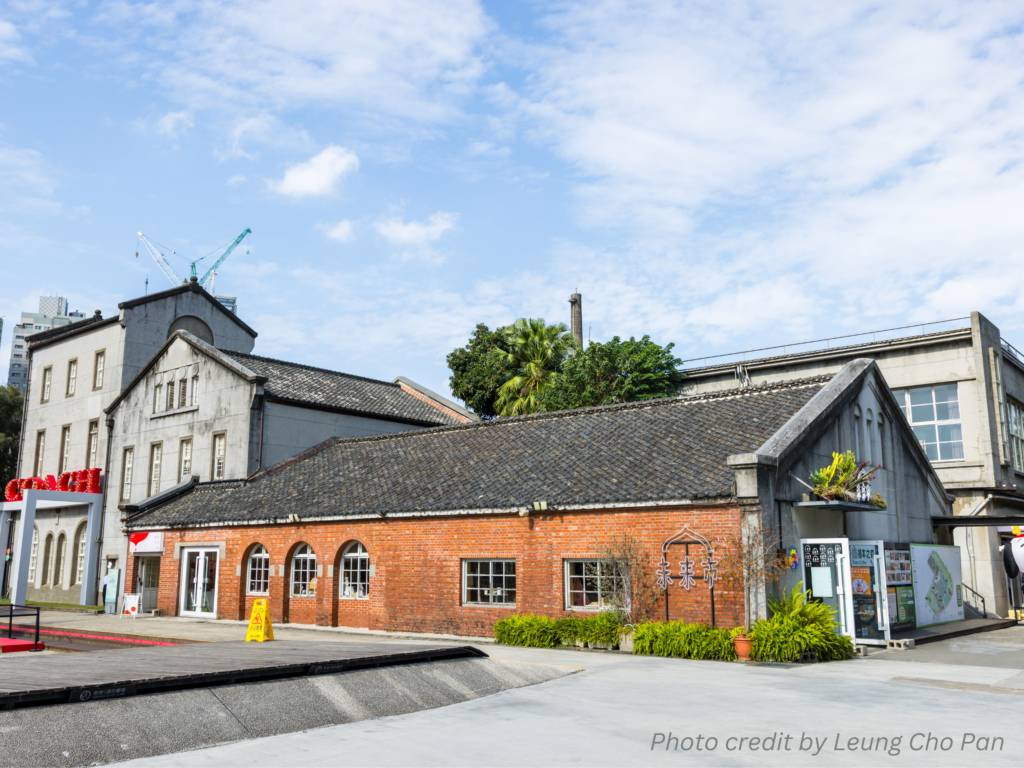
Walking through the ivy-covered brick buildings, we discovered a mix of permanent galleries and rotating exhibitions. The industrial architecture provided a striking backdrop for contemporary art installations. We particularly enjoyed browsing the design shops featuring local artists and the small indie coffee shops scattered throughout the complex.
Liberty Square and Chiang Kai-shek Memorial Hall
⏰ 11:00 AM – 12:15 PM (Day 4)
From Huashan, we took a quick 10-minute Uber ride to two of Taipei’s most important landmarks—Liberty Square Arch (自由廣場牌樓) and Chiang Kai-shek Memorial Hall (中正紀念堂).
We first arrived at📍Liberty Square Arch, a towering gateway leading into the vast public square. At the center stood📍Chiang Kai-shek Memorial Hall, its blue-tiled octagonal roof and bright white walls gleaming under the sun. The hall has four floors and houses souvenir shops, a post office, and several exhibits on Taiwan’s history.
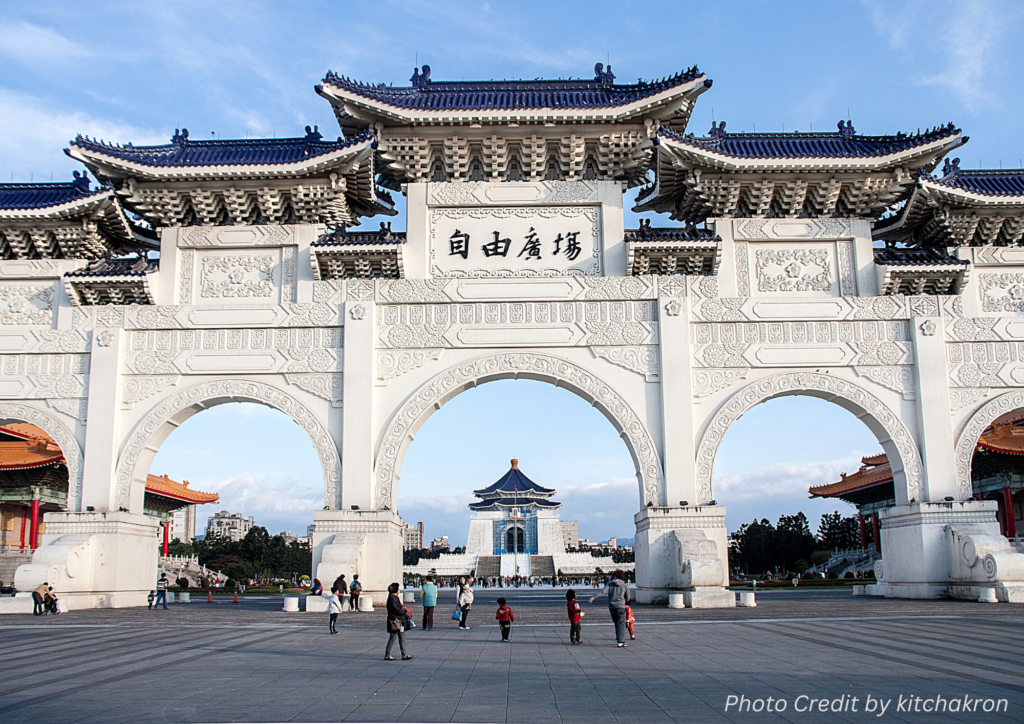
We spent most of our time in the exhibits beneath the main chamber. The displays covered Taiwan’s complex history, from the martial law period to its move toward democracy. Though most of the exhibits were in Chinese, we had no problem understanding key details with the help of Google Translate.
Just as we finished exploring, the changing of the guard ceremony was about to begin. We joined the crowd and watched the guards move in perfect sync and perform a well-coordinated ritual. The ceremony lasts about 15 minutes and occurs every hour from 9 AM to 5 PM (the last time we checked). It’s definitely worth seeing at least once if you visit.

After the ceremony, we briefly walked around Liberty Square’s gardens and open spaces. The setting was peaceful, the paths were well-maintained, and the beautiful views of the buildings made it a great place to hang out.
Bubble Tea at Its Birthplace – Chun Shui Tang
⏰ 12:30 PM – 1:30 PM (Day 4)
Bubble tea is a must-try in Taiwan, and📍Chun Shui Tang (春水堂) is one of the most famous local brands. It claims to be the inventor of bubble tea, so we couldn’t miss the chance to try it. Luckily, there was a branch inside the National Concert Hall, right in Liberty Square. The branch also serves traditional Taiwanese dishes, making it a good spot for lunch or snacks.
We ordered the original bubble tea (珍珠奶茶) and wheat germ milk tea (胚芽奶茶), both cold, with 30% sugar and less ice. The tea was strong and flavorful, and the tapioca pearls (aka the “bubble” or 珍珠) were perfectly chewy. Of the two, we liked the wheat germ milk tea more because of its ultra-rich, nutty taste and additional layers of texture.

Hands-on Pineapple Cake Workshop
⏰ 1:30 PM – 4:00 PM (Day 4)
As a passionate home-baker myself and a huge fan of Taiwanese pineapple cakes (鳳梨酥), my partner and I couldn’t pass up the chance to learn how to make this beloved treat while in Taiwan!
We booked a 2-hour hands-on baking class at📍Kuo Yuan Ye Museum of Cake and Pastry (郭元益糕餅博物館). We learned to make the buttery shortbread dough, carefully balancing the right ratio of flour, butter, and milk powder to achieve that signature crumbly texture. While the pineapple filling had been pre-made for us, we practiced wrapping it inside the dough—getting the thickness just right and sealing the edges properly took some patience!
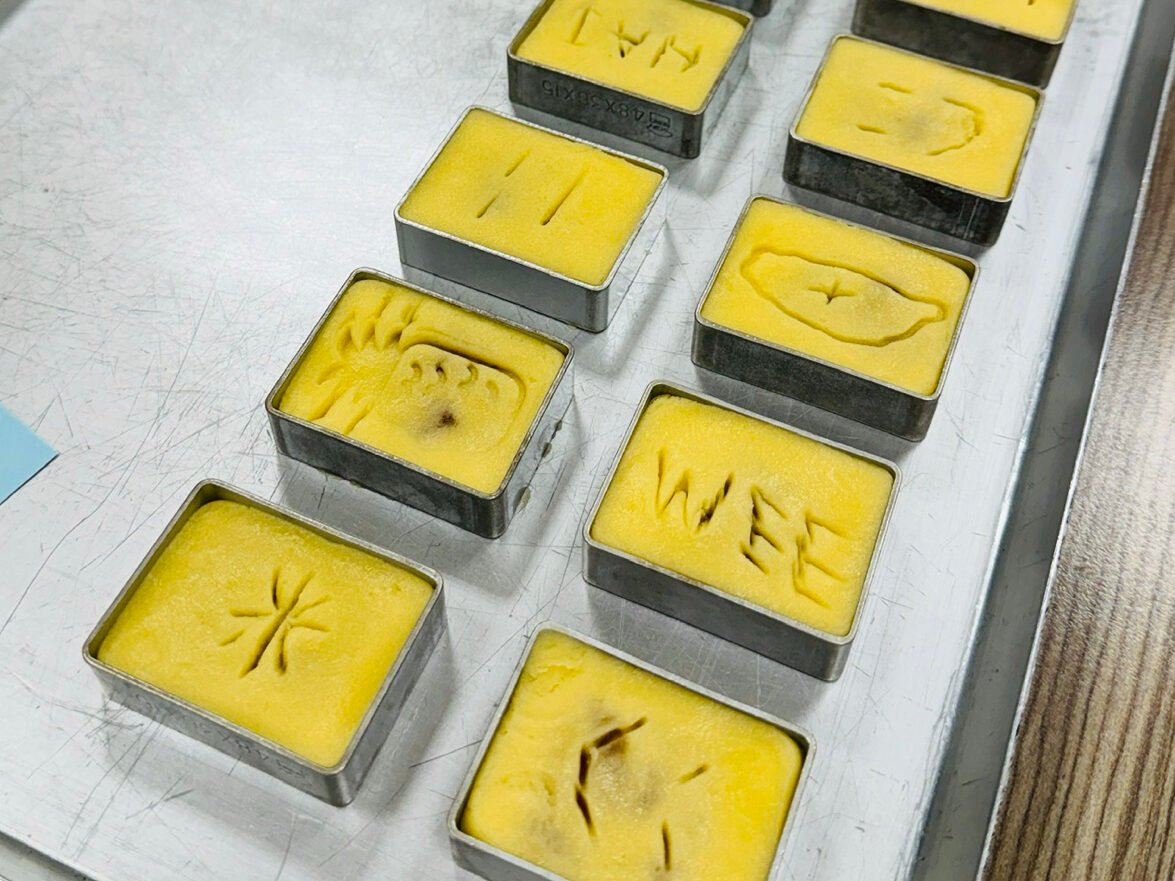
While our cakes were baked in the oven, we explored the museum on an interactive, guided tour. We learned about the history of Taiwanese pastries, local food culture, festivals, and rituals.

Finally, it was time to package our finished cakes! Seeing our beautifully hand-made pineapple cakes neatly packed in a box felt incredibly rewarding—they looked so professional! We left feeling proud of our creations, excited to bring them home as gifts, and inspired to try making them again with the recipe we received.

Early Dinner at Din Tai Fung
⏰ 4:00 PM – 7:00 PM (Day 4)
We wrapped up our day with an early dinner at📍Din Tai Fung (鼎泰豐), home to some of the world’s best xiaolongbao (小籠包). Having visited its branches in the U.S., we were excited to explore the much larger menu at its Taiwan branches, which featured a variety of dishes we hadn’t tried before.
Our feast included:
- 👍 Truffle and Pork Xiaolongbao (松露小籠包) – Rich, aromatic, and a luxurious take on the classic soup dumpling.
- 👍 Green Squash and Shrimp Xiaolongbao (絲瓜蝦仁小籠包) – Light, juicy, and refreshing with a delicate sweetness.
- 👍 House Special Spicy Shrimp and Pork Wontons (紅油抄手) – Perfectly chewy wontons coated in a flavorful, mildly spicy sauce.
- 👍 Din Tai Fung House Special (小菜) – A cold appetizer with a refreshing mix of marinated seaweed, bean sprouts, glass noodles, and tofu skin.
- 👍 Shaohsing Wine Marinated Chicken (紹興醉雞) – Tender, chilled chicken infused with the deep aroma of Shaohsing wine.
- 👍 Stir-fried Water Spinach (空心菜) & Stir-fried Amaranth Greens (莧菜)– Simple yet delicious veggie dishes, perfectly seasoned and wok-fried.
Every dish was executed with precision and quality. By the end of the meal, we were beyond satisfied—completely full and happy!

Travel Tips for Day 4:
- For Fuhang Soy Milk, arrive by 8:00 AM to keep wait time manageable. The line moves quickly, but it’s best to get there early for a more relaxed experience.
- Reservations for Din Tai Fung are highly recommended, as wait times can reach 1-2 hours during peak dining hours. If you don’t have a reservation, aim for non-peak times for a shorter wait.
- Alternative afternoon itinerary: If a pineapple cake workshop isn’t your thing, head back to Ximending and visit 📍Longshan Temple (艋舺龍山寺), one of Taipei’s most famous temples. Then, explore the 📍Bopiliao Historical Block (剝皮寮歷史街區), where historic streets meet modern art exhibits.


End of an Amazing 4-Day Taipei Adventure:
After four amazing days in Taipei, we felt like we had experienced the city’s perfect mix of history, culture, food, and nature. From bustling markets and historic sites to scenic hikes and hands-on activities, each day brought something new and exciting. Even on our second visit, Taipei’s charm still amazed us, making us appreciate its rich traditions and modern energy even more. As our journey continued beyond the city, we knew this wouldn’t be our last time here—we can’t wait for our third visit and many more to come!

Bonus for Foodies: More Night Markets, Breakfast Spots, and Local Flavors
Taipei is a food lover’s paradise. If you have an extra appetite, here are some additional foodie recommendations to take your Taipei food adventure to the next level!
🌙 More Night Markets:
- 📍 Nanjichang Night Market (南機場夜市): A hidden local favorite, known for its affordable and delicious eats. Unlike bigger night markets, this one feels more authentic and less commercialized.
- 📍 Raohe Night Market (饒河夜市): One of Taipei’s oldest and most famous night markets, known for its street food variety and lively atmosphere.
- 📍 Linjiang Street Night Market (臨江街觀光夜市): Also called Tonghua Night Market (通化街夜市), this is a go-to for late-night eats and offers a great mix of Taiwanese and international flavors.
🥢 More Breakfast Spots:
- 📍 Xiao Lu Yu (小魯玉): A small breakfast shop with traditional Taiwanese morning favorites, served fresh and hot.
- 📍 Liu Mama Rice Ball (劉媽媽飯糰): A famous spot for Taiwanese fan tuan (飯糰), or sticky rice rolls, stuffed with delicious fillings.
- 📍 How Chu Breakfast (好初早餐): A modern twist on Taiwanese breakfast, blending local flavors with creative presentations.
🥘 More Traditional Taiwanese Flavors:
- 📍 Shuang Yue (雙月): A Michelin Bib Gourmand restaurant known for its healthy, home-style Taiwanese dishes and a great spot for a sit-down meal that feels both nourishing and satisfying.
- 📍 Fu Ba Wang (富霸王豬腳), 📍 Huang Ji Braised Pork Rice (黃記魯肉飯), or 📍 Xiang Man Yuan (香滿園) – These restaurants specialize in braised pork dishes, a Taiwanese classic that pairs perfectly with steamed white rice.
- 📍 Men Qian Yin Wei (門前隱味牛肉麵), 📍 Lin Dong Fang (林東芳牛肉麵), or 📍 Liu Shandong (劉山東牛肉麵) – These restaurants serve some of the best beef noodle soup in Taipei, Taiwan’s most iconic comfort food.
Exploring Beyond Taipei: Easy Day Trips Ideas
Taipei is full of exciting things to do, but if you have extra time, day trips are a great way to see more of Taiwan. From historic towns and beautiful mountains to hot springs and coastal views, here are some easy trips from Taipei that are worth visiting.
1. Tamsui (淡水) – A Riverside Town with Beautiful Sunsets
Tamsui is a historic port town north of Taipei. It has old streets, colonial buildings, and a scenic riverside. It’s also famous for its street food and beautiful sunsets.
🚶♂️ Things to Do:
- Walk along Tamsui Old Street (淡水老街) – Lively shops and local souvenirs.
- Visit Fort San Domingo (紅毛城) – A historic fortress built by the Spanish, later used by the Dutch and British.
- Explore Tamsui Fisherman’s Wharf (淡水碼頭)– A great spot for sunset and home to the famous Lover’s Bridge.
- Try Local Snacks at Tamsui Yingzhuan Night Market (英專路夜市):
- A-gei (阿給) – Deep-fried tofu pockets and served with sauce.
- Dongshan Duck Head (東山鴨頭) – A crispy, flavorful street snack.
- Grass Jelly Dessert (燒仙草) – A sweet soup with grass jelly.
- Popcorn Chicken (鹹酥雞) – A crunchy night market favorite.
- Taiwanese Tempura (甜不辣) – A chewy, slightly sweet twist on tempura.
🚆 How to Get There: Take the MRT Red Line to Tamsui Station (last stop, about 40 minutes from Taipei Main Station).
⏳ Recommended Time: Half-day to full-day trip.
2. Jiufen (九份) – A Nostalgic Mountain Town
Jiufen is a small, charming mountain town with narrow alleys, tea houses, and red lanterns. Many people say it inspired scenes in Hayao Miyazaki’s Spirited Away. It’s one of my favorite places in Taiwan.
🏮 Things to Do:
- Explore Jiufen Old Street (九份老街) – Shops selling souvenirs, snacks, and crafts.
- Have Tea at A-Mei Teahouse (阿妹茶樓) – A famous teahouse with a beautiful mountain & ocean view.
- Try Jiufen’s Famous Snacks:
- Taro Ball Dessert (芋圓) – Chewy taro and sweet potato balls in syrup.
- Peanut Ice Cream Wrap (花生捲冰淇淋) – Ice cream, crushed peanut brittle, and cilantro wrapped in a crepe.
- Hike the nearby Mountain Time Boardwalk (報時山棧道) – A short and easy hike with stunning ocean and mountain views, plus historical ruins to explore.
🚆 How to Get There: Take a train from Taipei Main Station to Ruifang Station (40 minutes), then transfer to a bus or taxi to Jiufen (15 minutes). Alternatively, take a direct bus from Taipei (E.g., Bus 965 from Banqiao or Bus 1062 from Zhongxiao Fuxing MRT Station) for a cheaper, more convenient option.
⏳ Recommended Time: Full-day to 2-day-1-night trip.
3. Beitou (北投) – Taipei’s Hot Spring Town
Beitou is famous for its hot springs, nature trails, and relaxing atmosphere. It’s a great escape from the busy city.
♨️ Things to Do:
- Soak in a Beitou Hot Spring – Choose a public bathhouse like Beitou Public Hot Springs, or enjoy a private hot spring at a hotel.
- Visit Beitou Thermal Valley (地熱谷) – A steaming sulfur spring lake, also called “Hell Valley.”
- See the Beitou Hot Spring Museum (北投溫泉博物館) – A former Japanese bathhouse turned museum.
- Check Out Beitou Library & Plum Garden – Beitou Library is one of Taiwan’s most eco-friendly buildings, and Plum Garden was home to a famous Taiwanese artist.
🚆 How to Get There: Take the MRT Red Line to Beitou Station, then switch to the Xinbeitou Line for one stop to Xinbeitou Station.
⏳ Recommended Time: Half-day to full-day trip.
4. Yehliu Geopark (野柳地質公園) – Taiwan’s Natural Wonder by the Sea
Yehliu Geopark is one of Taiwan’s most unique natural attractions, famous for its otherworldly rock formations created by years of wind and sea erosion. Located along Taiwan’s northern coast, this scenic park offers stunning ocean views and fascinating geological sights.
🪨 Things to See & Do:
- Queen’s Head (女王頭) – The park’s most famous rock formation, resembling a queen’s profile. It is slowly eroding, so see it while you can!
- Fairy’s Shoe (仙女鞋) & Candle Rocks (燭台石) – Other fascinating formations shaped by natural forces over thousands of years.
- Wave-Cut Platforms & Sea Caves – Walk along the rugged coastline and admire the breathtaking interaction between land, sea, and sky.
- Tide Pool Exploration – Spot crabs, small fish, and marine life in the shallow pools along the rocky shore.
🚆 How to Get There: Take Bus 1815 from Taipei Main Station (bound for Jinshan) and get off at Yehliu Geopark Station (approx. 90 minutes). Alternatively, take a train to Keelung Station, then a local bus to Yehliu.
⏳ Recommended Time: Full-day trip.
5. Yangmingshan National Park (陽明山) – A Scenic Escape Just Outside Taipei
Yangmingshan National Park is a lush, mountainous retreat just outside Taipei, known for its hot springs, hiking trails, and seasonal cherry blossoms. It’s the perfect day trip for nature lovers, offering cool, fresh air and breathtaking views.
🏔 Things to See & Do:
- Xiaoyoukeng (小油坑) – A volcanic crater with steaming fumaroles and sulfur vents, a reminder that the area is still geothermally active.
- Qingtiangang Grassland (擎天崗) – A wide, open field with roaming water buffalo and stunning mountain views, great for easy hikes and picnics.
- Lengshuikeng Hot Springs (冷水坑) – A free public hot spring, perfect for soaking tired feet after hiking.
- Yangmingshan Flower Festival (春季花季) – Visit in spring (Feb-April) to see vibrant cherry blossoms, azaleas, and calla lilies.
- Hike to Mount Qixing (七星山) – At 1,120 meters, it’s Taipei’s highest peak, with rewarding 360-degree city and ocean views.
🚆 How to Get There: Take Bus 260 from Taipei Main Station or Bus R5 from Jiantan MRT Station to Yangmingshan Bus Terminal (~40-50 minutes). From there, transfer to a Yangmingshan shuttle bus to reach different scenic spots.
⏳ Recommended Time: Full-day trip.
Final Thoughts
Taipei is a city where you can slow down, explore, and enjoy its rich culture, beautiful scenery, and incredible food. From bustling night markets to peaceful mountain views, every corner has something special to offer. Whether you’re savoring a bowl of beef noodle soup, sipping tea in Maokong’s hillside teahouses, or strolling through the historic streets of Dadaocheng, Taipei will leave you with unforgettable memories. We hope this guide helps you plan a fun and relaxed trip to this amazing city. If you’re excited to see more of Taiwan, stay tuned—we’ll be sharing our experiences in Taichung, Tainan, Sun Moon Lake, and Alishan soon! ✨
The End. Happy Traveling!
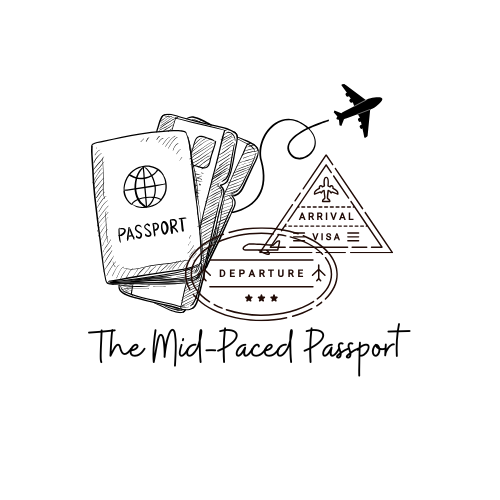



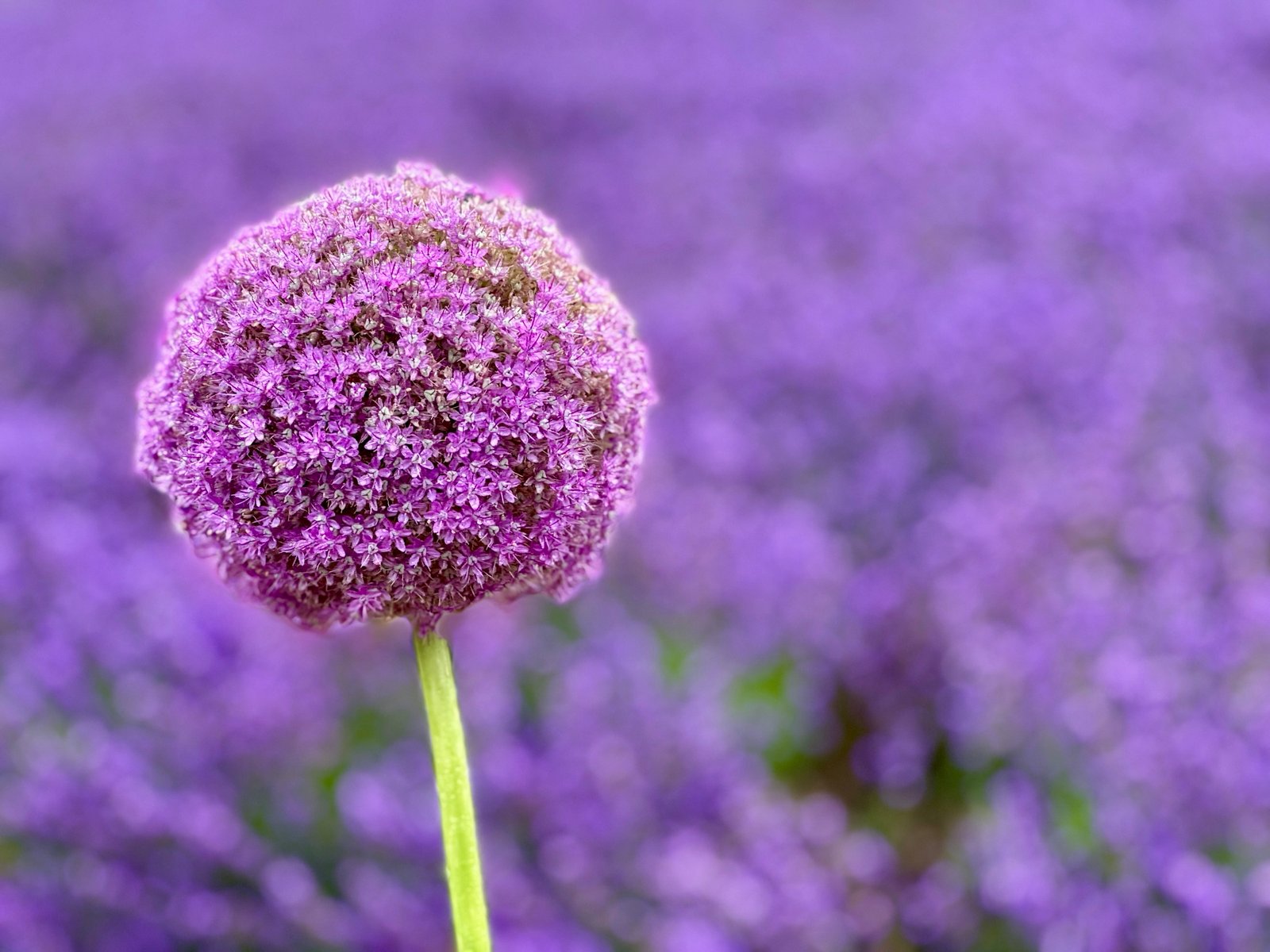
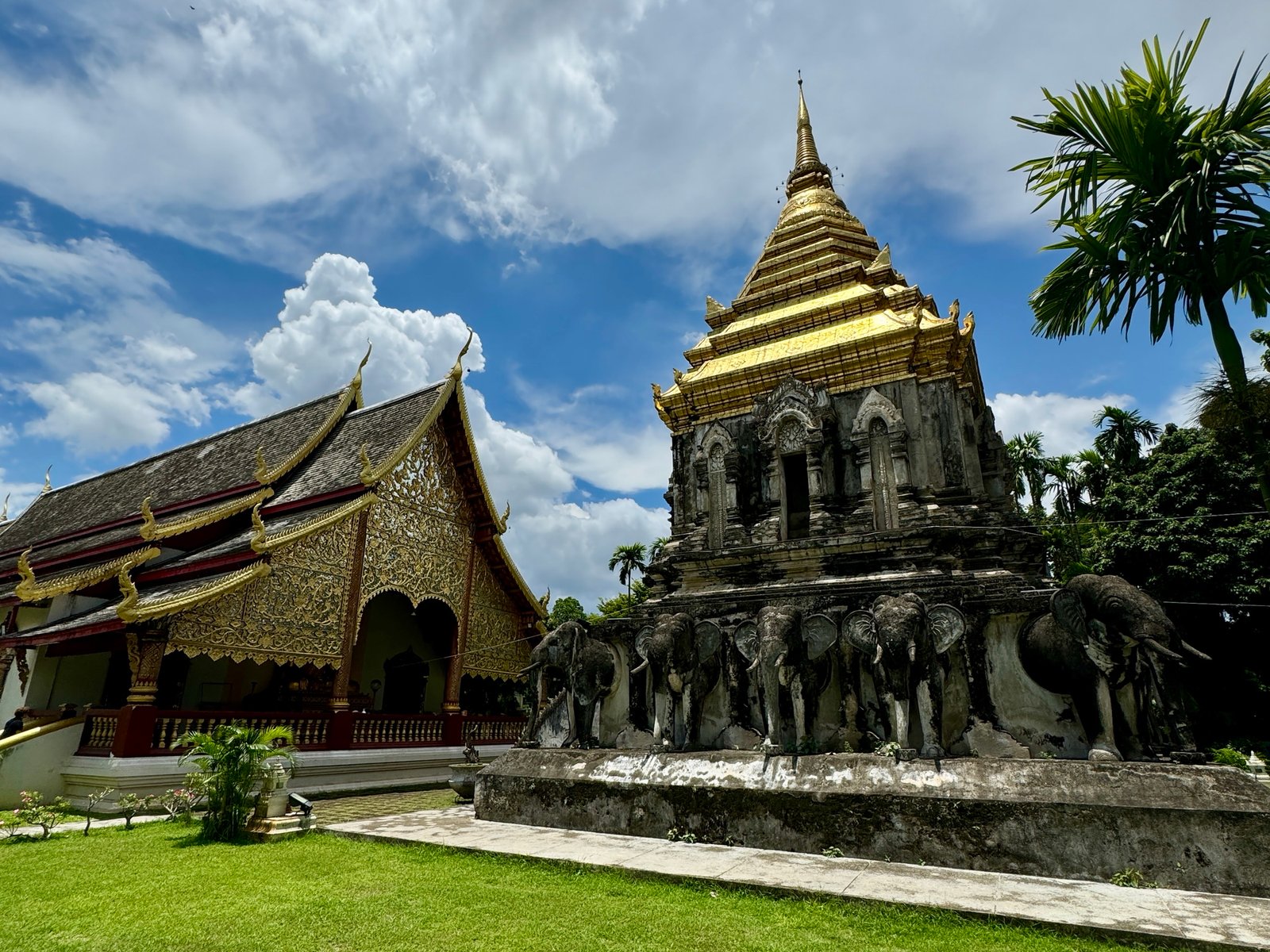
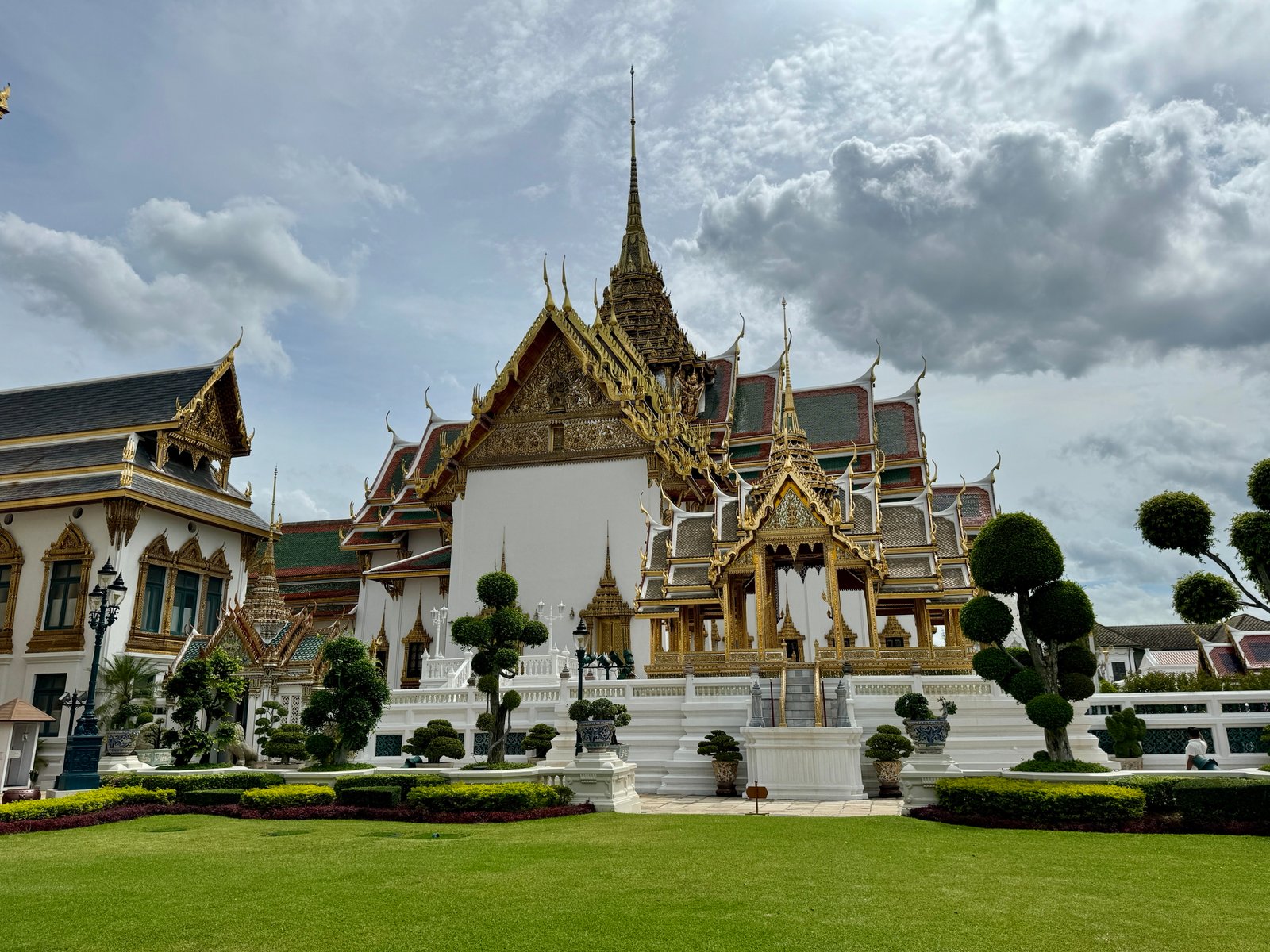

Leave a Reply